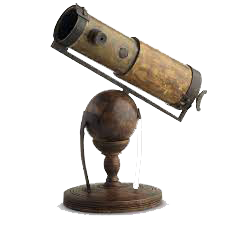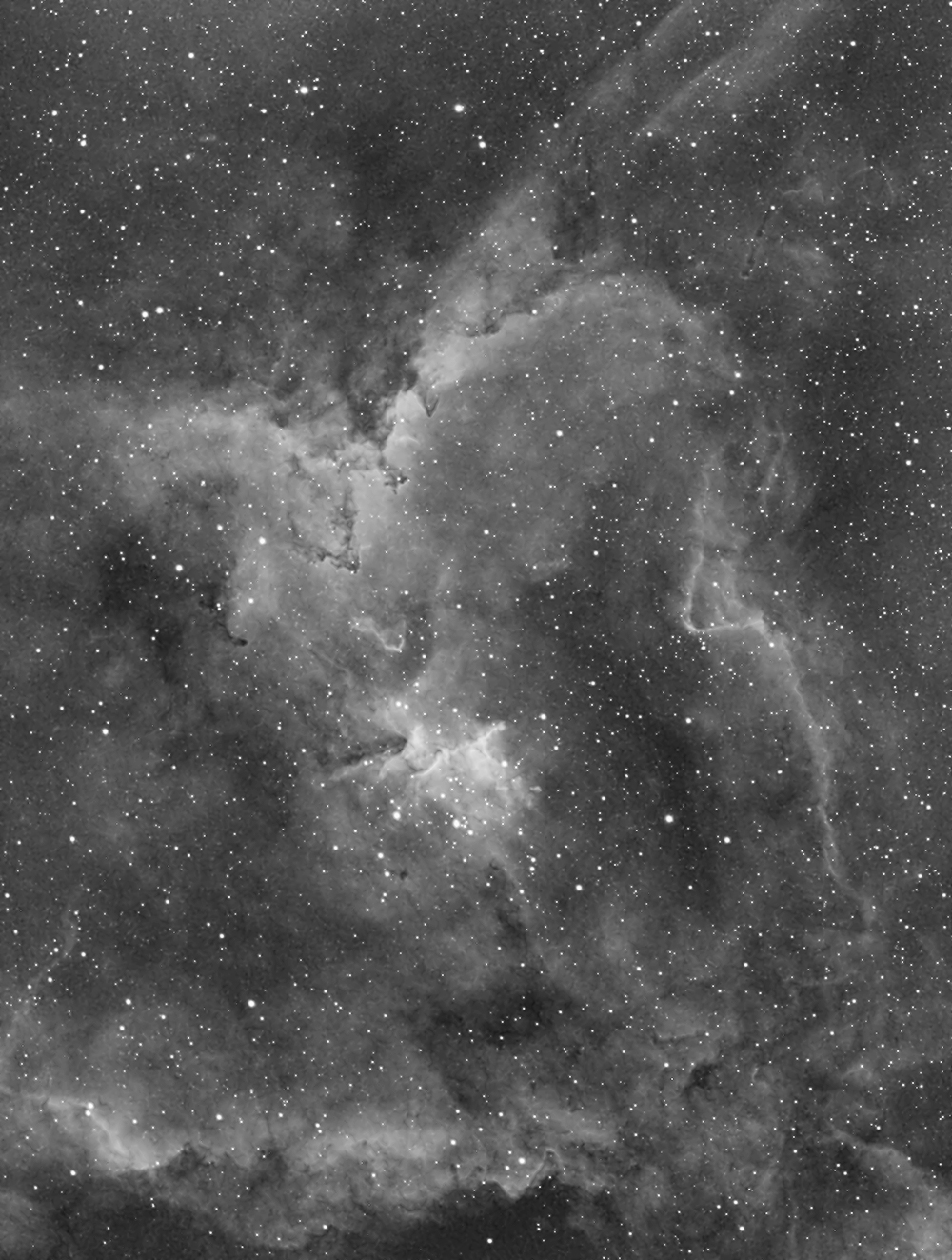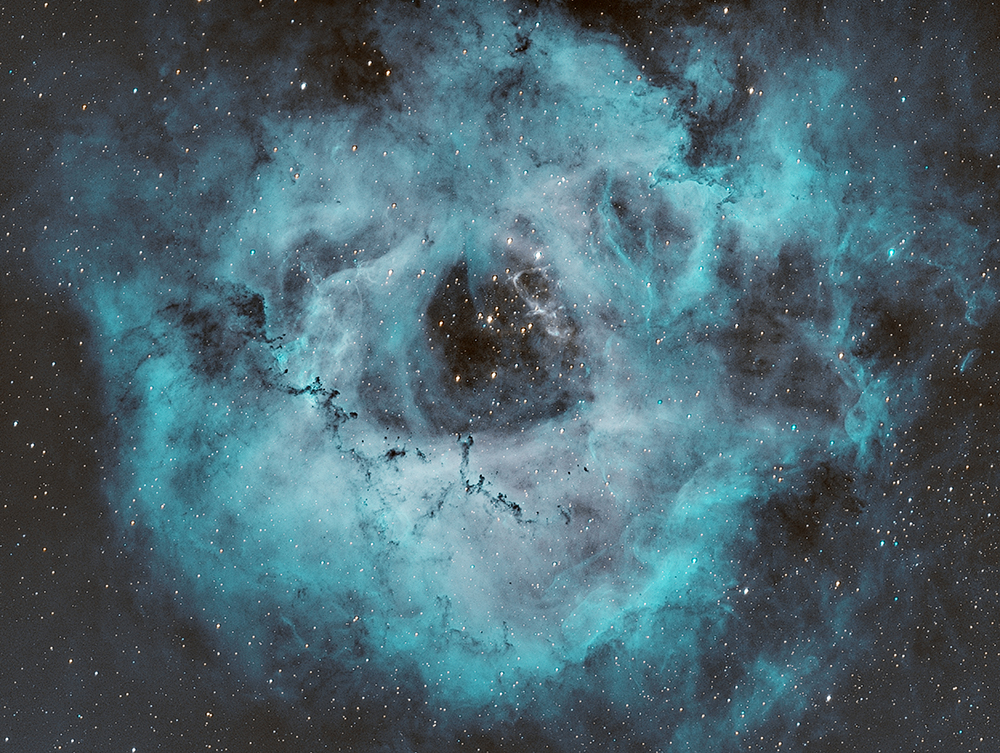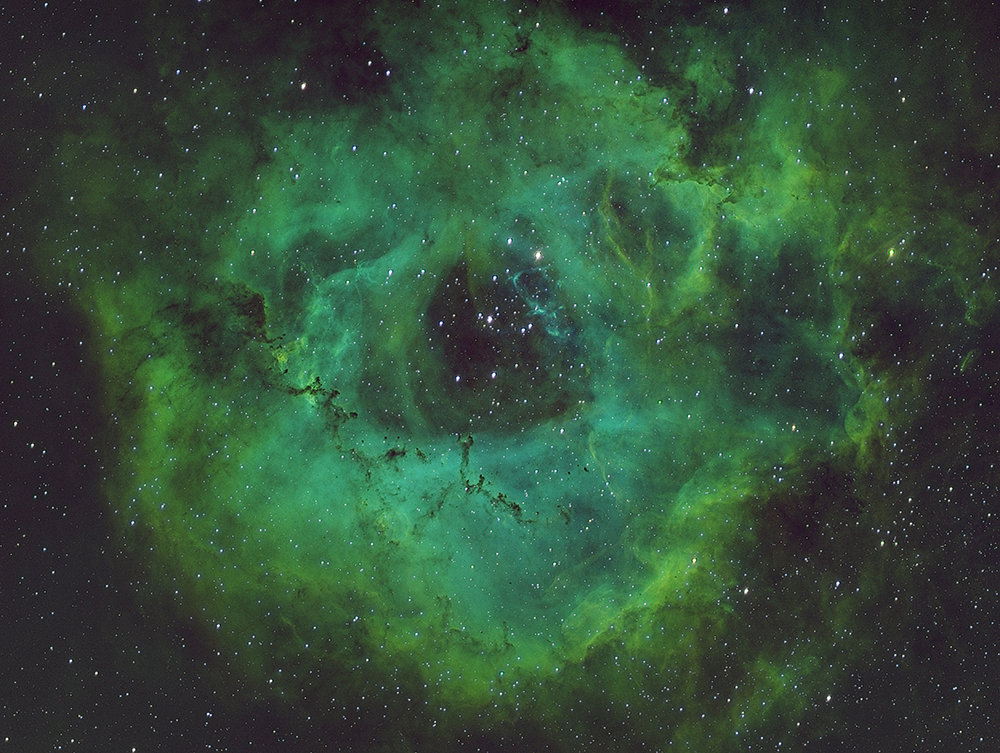
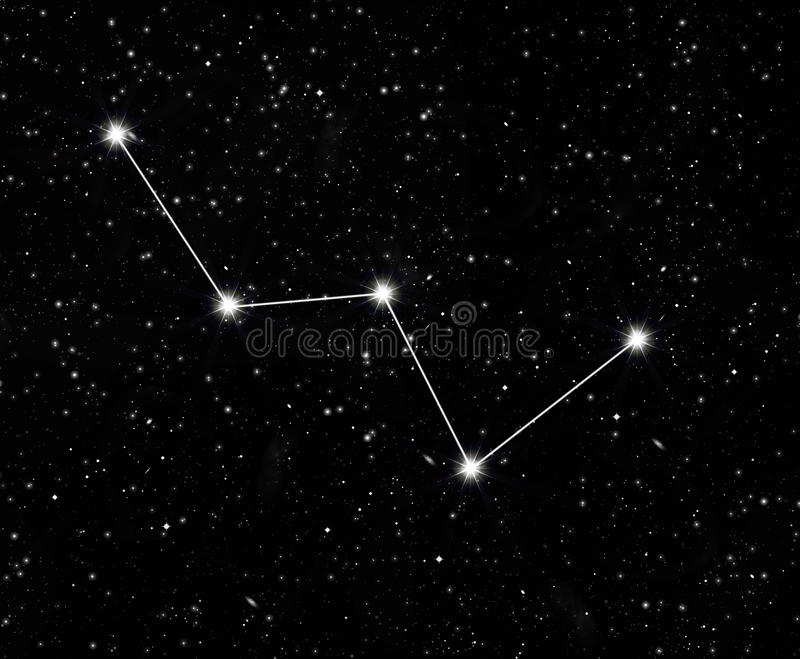
The
Observatory
Cassiopeia is our personal astronomical observatory, located on the grounds of the much larger E.C. Carr Astronomical Observatory.
The E.C. Carr is owned by the Toronto Centre of the Royal Astronomical Society of Canada.
The sprawling site is atop of the Blue Mountains, in Ontario, Canada, and its northern vista is over the large body of water known as Georgian Bay.
While not a true 'Dark Sky' site, its an excellent compromise, especially in consideration of the nature of the astronomical gear/instruments being used here.
Cassiopeia was built around 2014 by the former Director of the E.C. Carr Astronomical Observatory. This observatory has contributed to published astronomical research at the University of Toronto.
The former director had owned it for about eight years, when we purchased the physical structure in Summer 2022.
The actual site, with its power and internet, etc., is leased from the Royal Astronomical Society of Canada. The main building on the grounds has all the comforts of home, bedrooms, lecture hall, kitchens, etc.
One of the references for build concepts for our observatory was Wayne Parker, developer of the Sky Shed. We have a row of his Sky Sheds at the site ... they are the round, gray & white observatories.
CLICK: Wayne Parker and his observatory designs
The name Cassiopeia became attached to this observatory during a summer 2022 Work Party at the Carr Astronomical Observatory, at the moment a still-rising Cassiopeia (the constellation) loomed large over a well-treed rise in land to the East,with her stars noticeably burning with unusually intense light. A poet might have written, at that moment, that she was looking in on us.
It was that viewing-of-Cassiopeia that started the ball rolling that actually resulted in us acquiring this observatory, just days later.
I was part of that Work Party because I am, and have been for several years, one of the administrators of the EC Carr itself. Come 2023, I will also be onsite, when scheduled, as a supervisor. This additional role's responsibilities include overseeing all activity onsite, which means all of the many observatories and telescopes and computers, etc., and living accommodations.
The main instrument that we have installed in Cassiopeia is a blisteringly "fast"11-inch Celestron RASA (Rowe-Ackerman Schmidt Astrograph), at 620mm focal length.
This university-level instrument has tremendous light-gathering capability, at f/2.2.
It sits on Celestron CGX-L mount, which is bolted to a welded steel "pier" ... which is bolted to a concrete support column that goes 5-1/2 feet into the ground.
The main imaging camera will be a ZWO 1600 Cool monochrome CCD camera, with its own cooling system which can take the sensor down to -20C when capturing data, which is vital for gathering "good" data.
Ironically, the 11" RASA is such that you cannot look through it .... it is all done via a computer.
Filters will primarily be Hydrogen alpha, Oxygen III and Sulphur II. There will also be wide use of R, G, B and Ultra-High Contrast.
Capture software will primarily be Sequence Generator Pro and processing mostly with PixInsight.
Guiding will be provided via an Evostar 50ED, focal length 242mm, and a ZWO 180 monochrome camera. Guiding software is PHD Guiding, a standard for this discipline.
All optical systems have 12v DC dew heaters installed on them.
The actual building and the concrete pier/instrument column do not touch -- they are physically separated -- so that vibrations in the building do not transfer to the instrumentation.
One of the best features of this observatory? It also has a 'warm room', so no working through a cold night. Only one other observatory at the CAO has this very-welcome feature, the large Geoff Brown Observatory.
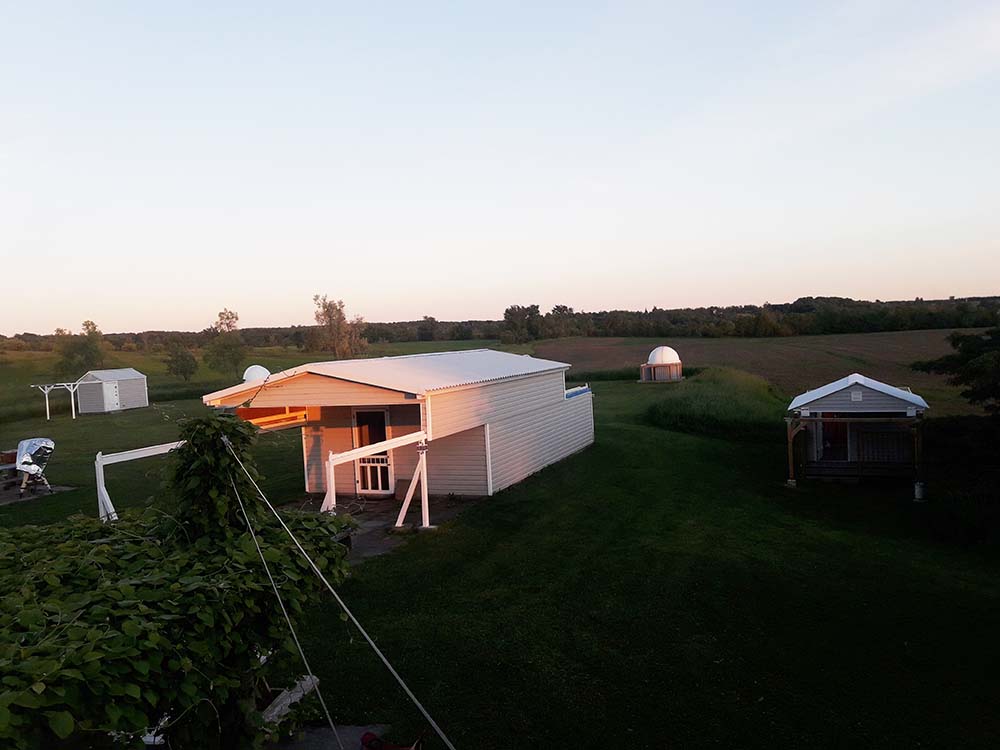
Here
is part of the CAO, looking south from the main
building. There are actually nine observatories in
this image, it's just that some are hidden by other
buildings. The large building, front and
centre, is the Geoff Brown Observatory. The smaller
roll-off roof observatory, to the immediate right is
for imaging only. There are six round 'Sky
Sheds' at the back. Off to the left, with its
roof rolled back in the out-of-use position is our
observatory, Cassiopeia. Not all of the
observatories, sited at the CAO, are in this image.
Note that three here are of the roll-off roof
design. This design offers the possibility of also
having a 'Warm Room' in the building. The
Geoff Brown and Cassiopeia both have -- very comfy
-- warm rooms.

Click to enlarge:
Here is a just-launched rocket view of the part of
the larger CAO site where our personal observatory,
Cassiopeia, is located. That's her to the left
... the odd-looking rectangular building ... with
the outriggers.
View is from one of the many small rockets that can get launched from the CAO.
View is from one of the many small rockets that can get launched from the CAO.
History
of the site
The E.C. Carr Astronomical Observatory is a 55-acre site owned by the Toronto Centre, of the Royal Astronomical Society of Canada.
The so-called CAO devotes about five acres to astronomical pursuits, and we rent out the remaining acreage to local farmers.
The CAO includes a large, communal-living-style home with unique features that focus on maximizing its specific utility for astronomical education. You name it, it's there .... workshop, lecture room, bedrooms, huge common kitchen and multi-purpose room, etc. It is wheelchair accessible.
Also onsite are a large garage/shed crammed with everything you need to maintain such a property.
And let's not forget about the multiple observatories there.
First off, there is the very large Geoff Brown Observatory (GBO), with its huge roll-off roof and its large "warm" room. Also, the Sue-Lora Observatory (SLO) which is a built-for-members imaging-specific asset.
There are multiple MODL, round mini-observatories, one smaller roll-off roof observatory, with a smaller "warm" room.
And there is the Tony Horvatin Observatory (THO), with is used by members who set up their own gear inside.
There is also the generous Observing Pad, which is a large, rectangular patio-style area where members can set up telescopes and imaging rigs, etc. Helpfully, for important 'polar alignment' the Observing pad is aligned with the North Star, Polaris.
Everything mentioned is integrated with supplied electrical power and Internet.
In addition to the communal living main house, the CAO also has sites for camping and RV use.
Everything is protected by multiple and sophisticated alarm systems.
The CAO regularly hosts education/outreach events, sometimes with notable leaders of the scientific community.
Due to the COVID pandemic and lockdowns/health guidance, the CAO has been operating for two years plus at minimal levels. We anticipate returning to normal levels of activity and public events in Spring 2023.
The site is "walking-close" to the Bruce Trail.
NOTE: There are several non-Cassiopeia photos, at the very bottom of this web page, which show many aspects of the CAO. Just scroll down ....
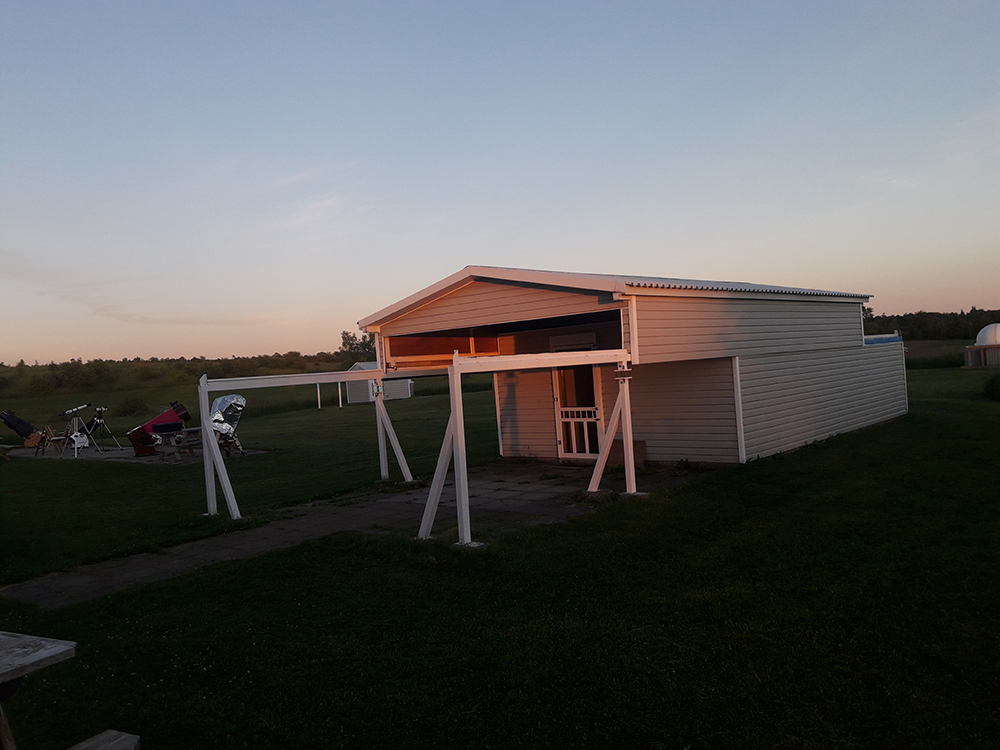
Click to enlarge: The Geoff Brown Observatory. You can see some of the MODL observatories in the background and the Observing Pad, to the left of the GBO.
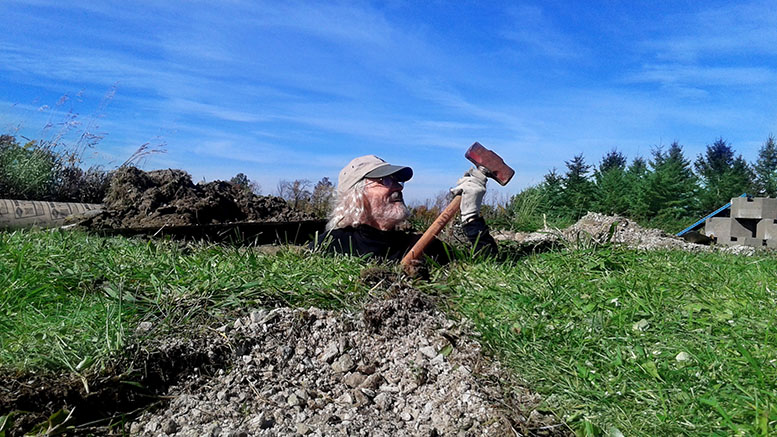
When we installed the last MODL observatory, I think in 2018, we had some issues with the excavation for the concrete pier, upon which the instrument assembly was to eventually be mounted to. This vital first step in observatory construction has to be done correctly, no cutting of corners. Turns out, we had some side slip in the excavation and Clay had to get into it to clean it all out, before any concrete could be poured. Clay is about 5-foot 8-inches tall .... so, this image clearly shows how deep we go with the concrete foundations for the telescope installations at the CAO site.
The
Goddess Cassiopeia
Cassiopeia, a figure in Greek mythology, was Queen of Aethiopia and wife of King Cepheus. She was arrogant and vain, characteristics that led to her downfall.
Cassiopeia boasted that she and her daughter Andromeda were more beautiful than all the Nereids, the nymph-daughters of the sea god Nereus. This brought the wrath of Poseidon, ruling god of the sea, upon
.jpg) the kingdom of Ethiopia.
the kingdom of Ethiopia.Accounts differ as to whether Poseidon decided to flood the whole country or direct the sea monster Cetus to destroy it. In either case, trying to save their kingdom, Cepheus and Cassiopeia consulted a wise oracle, who told them that the only way to appease the sea gods was to sacrifice their daughter.
Accordingly, Andromeda was chained to a rock at the sea's edge and left to be killed by the sea monster. Perseus arrives to kill Cetus, saves Andromeda and marries her.
Poseidon thought Cassiopeia should not escape punishment, so he placed her in the heavens chained to a throne in a position that referenced Andromeda's ordeal. The constellation resembles the chair that originally represented an instrument of torture. Cassiopeia is not always represented tied to the chair in torment, in some later drawings she holds a mirror, symbol of her vanity, while in others she holds a palm frond.
The Constellation Cassiopeia
Cassiopeia is the 25th largest constellation in the night sky, occupying an area of 598 square degrees. It lies in the first quadrant of the northern hemisphere (NQ1) and can be seen at latitudes between +90° and -20°. The neighboring constellations are Andromeda, Camelopardalis, Cepheus, Lacerta, and Perseus.
.
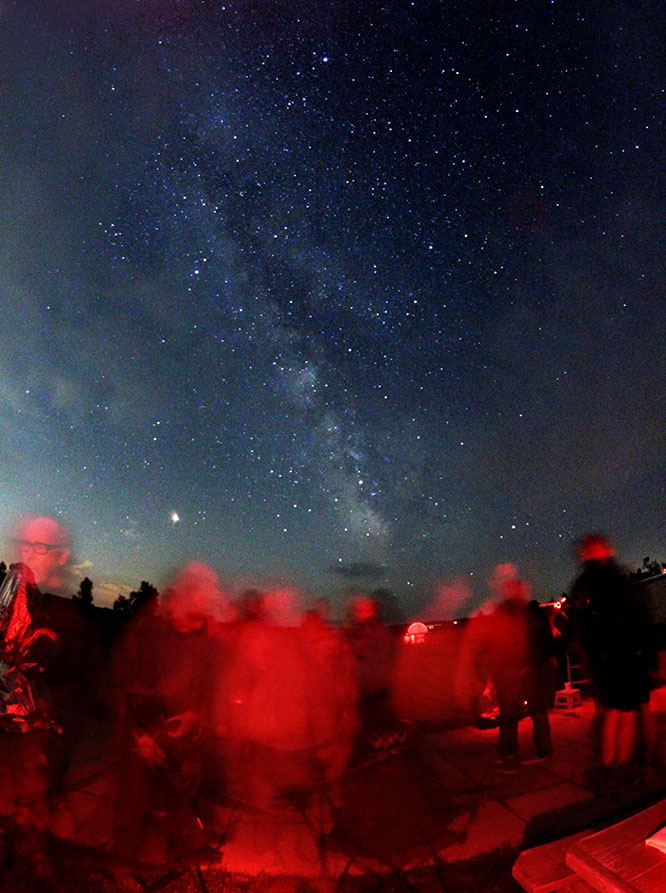
The night sky here is spectacular. You can easily see the Milky Way and all of the planets out to Saturn,
assuming they are in the sky. Every once in a rare while, when our solar system co-operates,
we can see five planets at once ... Mercury, Venus, Mars, Jupiter and Saturn. And if we count
the one we're standing on, that would make it six.
We work under red light only, to protect our night vision. This image is from one of the last
education outreach events we did, just before the COVID lockdown. This is a group of area business people.
We are hoping to return to normal operations in Spring 2023.
.
 VIDEOS
(1) First
Test of Instrumentation & Computers
(2)
Driving
to the site, fall colours
(3) Adrian's
GoPro video, CAO Visit
VIDEOS
(1) First
Test of Instrumentation & Computers
(2)
Driving
to the site, fall colours
(3) Adrian's
GoPro video, CAO Visit

The cloak of night is passing over the CAO ... . looking North from the Observatory. You can see the CAO's main residence.
Once darkness falls, all activity is done under red light -- because it preserves our 'night vision.'
Look at those goregous twilight colours ....
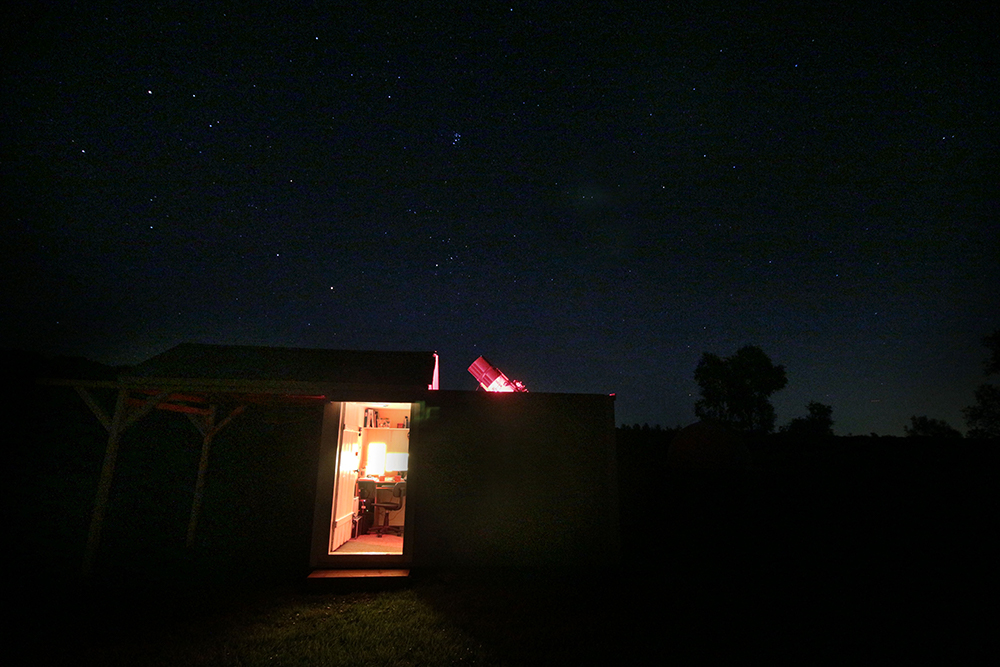
Cassiopeia is getting prepared for another night's work, moving aside a cosmic curtain that allows astronomers to witness breathtaking things ....
You can see the 'Warm Room' behind the still-open door ... it is bright in this image because both computers' monitors are on, as are the red and while illumination in the warm room.
You can also see how the roll-off roof is now retracted and the 11-inch Rowe Ackerman Schmidt Astrograph is in its "ready" position ... which means it is locked onto Polaris, the North Star. The Northern hemispher sky rotates, in a counterclockwise direction, around the Polaris region.
Part of the original set-up procedure was aligning this instrument -- exquisitely precisely -- with the point of true North, which is just beside Polaris. This was achieve by using a special "PoleMaster" camera and one of the computers.
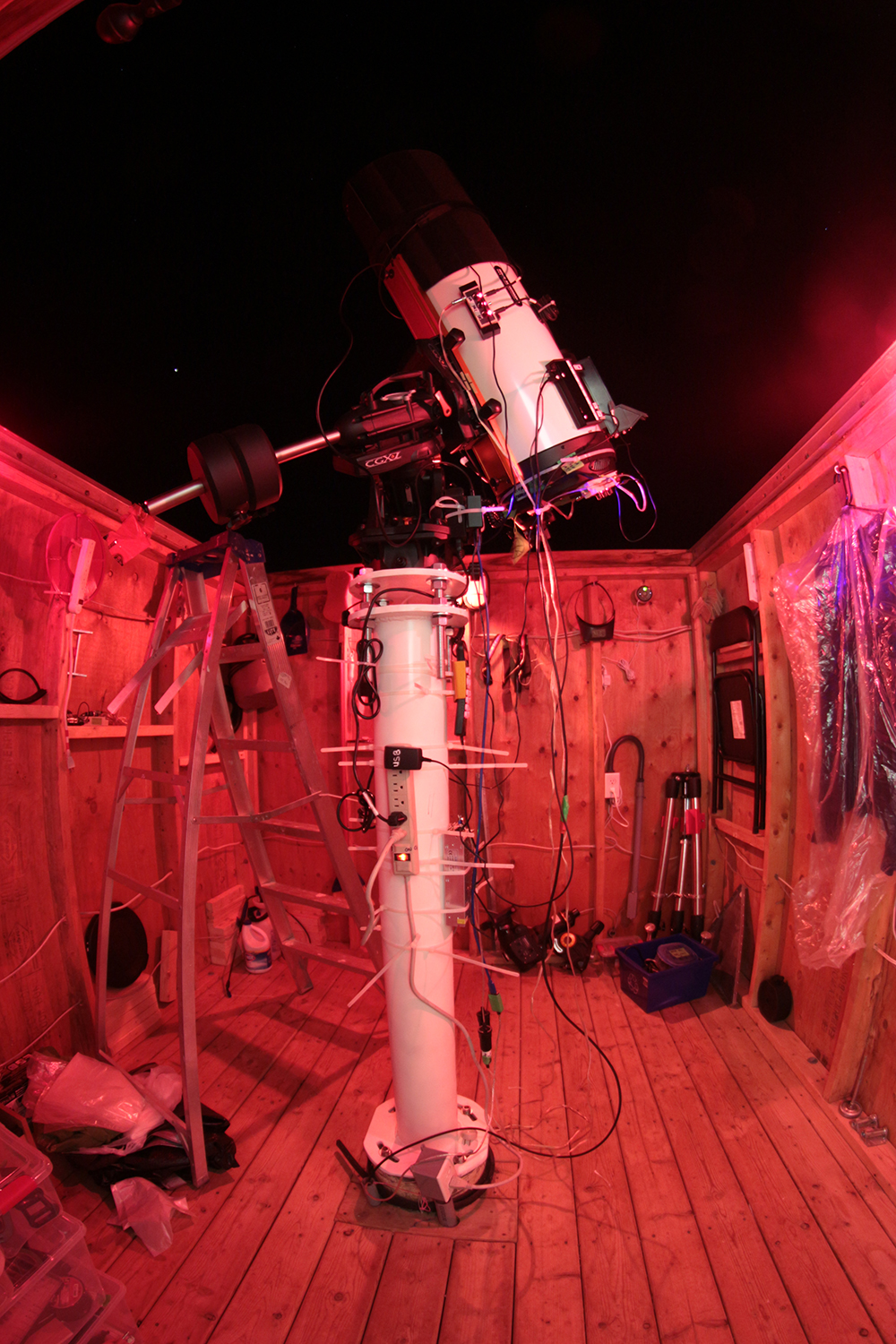
The electrical controls are linked to a variety of features, such as: an electric focus motor, header bands on all of the optics, the imaging camera, the guide-system camera, the internal fan, etc.
Note the red light, again.
That violet light is actually one of the security system camera, which cannot be seen visually ... but which can be seen via this kind of photography.
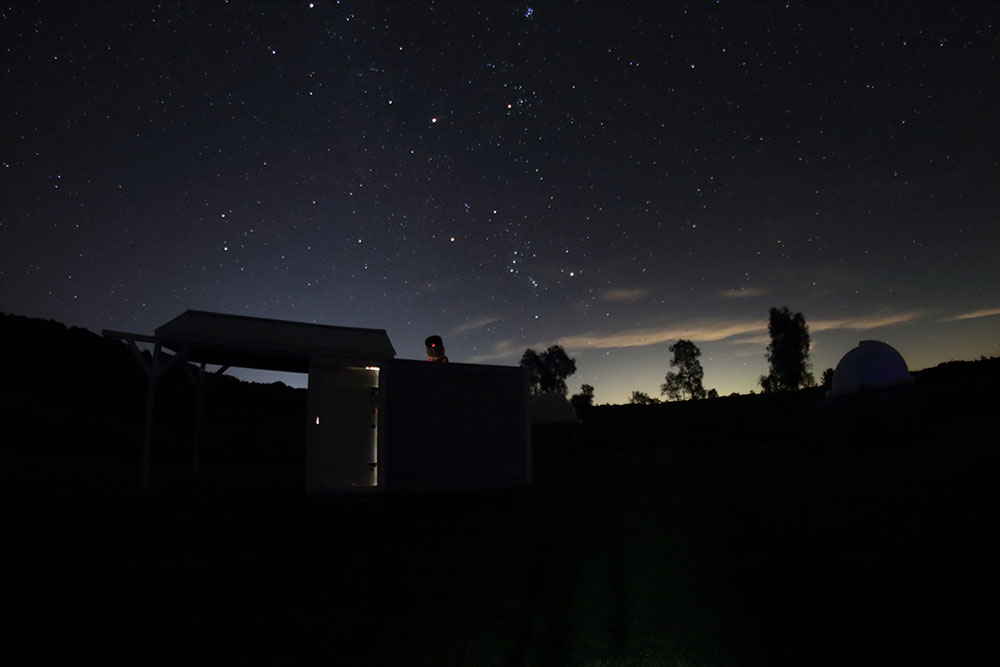
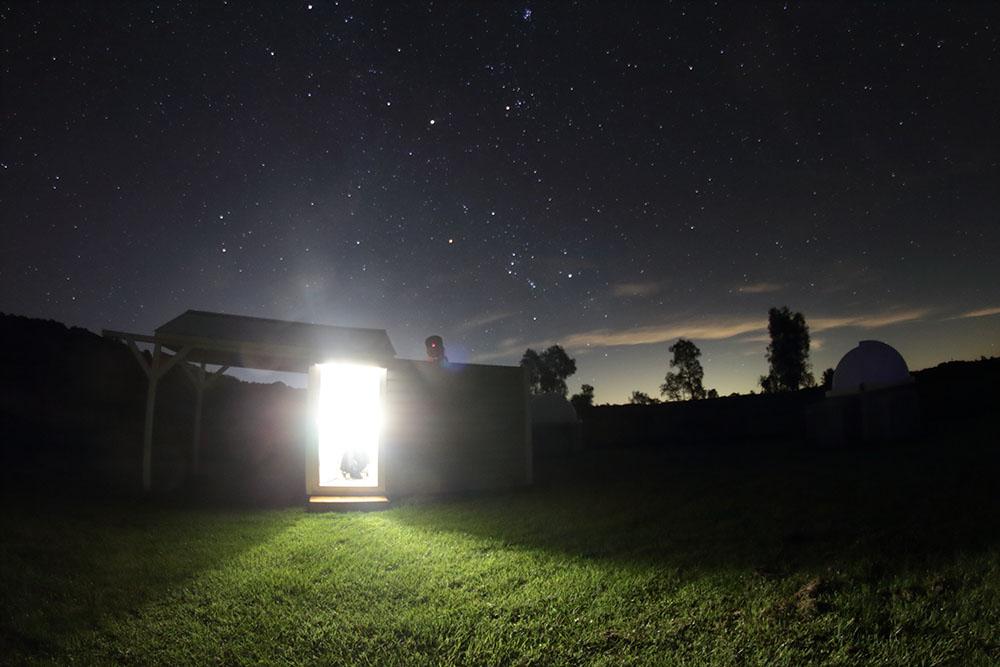
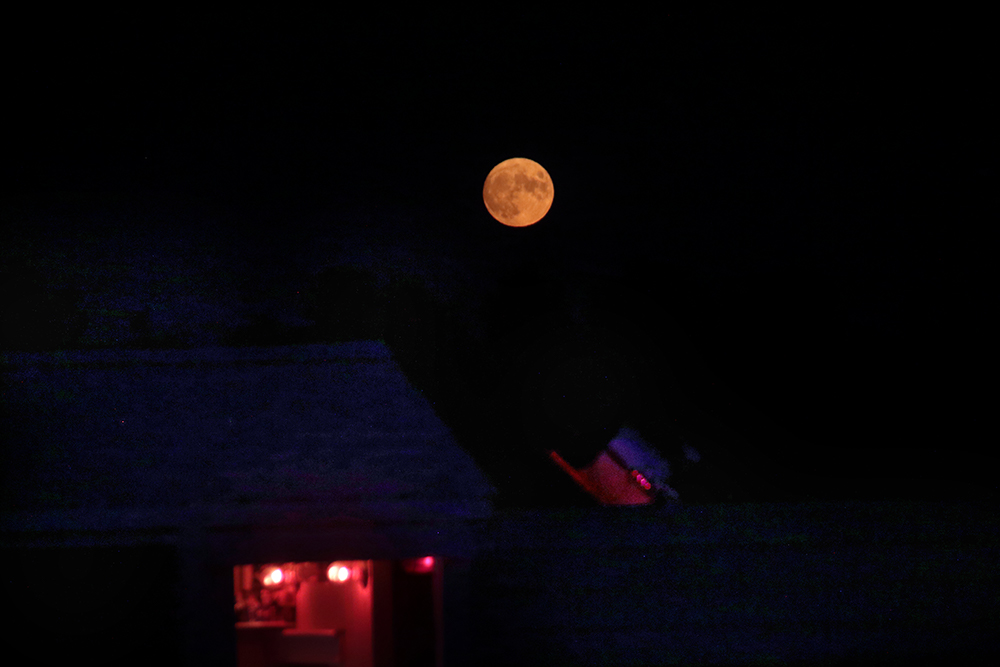
Definitely not a 9-to-5 job .... that door actually closes and there is a light-stopping curtain also. Also, there is a small window, between the Warm Room and the Instrument Deck ... somewhat hidden behind the mount. The window also has a pull-down blind on it ... to keep unwanted light out of the Instrument Deck when the instrument is working ... as it is just about to here, in this photo. The mount and its instrumentation are in the 'Park' position, which means it is locked solidly onto Polaris, the North Star. |
When not working, the instrumentation sets itself into the 'Observatory Park' position, which allows all of this pricey technology to be clear of crashing into the roof, when it rolls back into the 'Closed & Locked' position. We have an electric roof opener, for the roof, currently stored at our home in Oakville. It will be installed next spring. These images from one of the security cameras onsite. |
|
||||||
 The Great Andromeda Galaxy. Imaged in visible light ... R ... G ... B .... plus Hydrogen-alpha. The Ha contribution can be seen as the deep reddish clusters, in the spiral arms of the galaxy and in the reddish cast of the bright core, all of which reveal star creation regions. This image represents just over 10 hours in total exposure. It is a 2-panel mosaic. The galaxy's name stems from the area of Earth's sky in which it appears, the constellation of Andromeda, which itself is named after the princess who was the wife of Perseus in Greek mythology. ☆ ☆ ☆ ☆ ☆ ☆ ☆ ☆ ☆ ◉ The Milky Way and Andromeda galaxies are expected to collide in around 4–5 billion years, merging to potentially form a giant elliptical galaxy or a large lenticular galaxy. ◉ The Andromeda Galaxy is among the brightest of the Messier objects, and is visible to the naked eye from Earth on moonless nights, even when viewed from areas with moderate light pollution. ◉ It was mentioned as early as 965 ce, in the Book of the Fixed Stars by the Islamic astronomer al-Ṣūfī. ◉ Only in the 1920s did the American astronomer Edwin Powell Hubble determine conclusively that the Andromeda was in fact a separate galaxy beyond the Milky Way. |
||||||
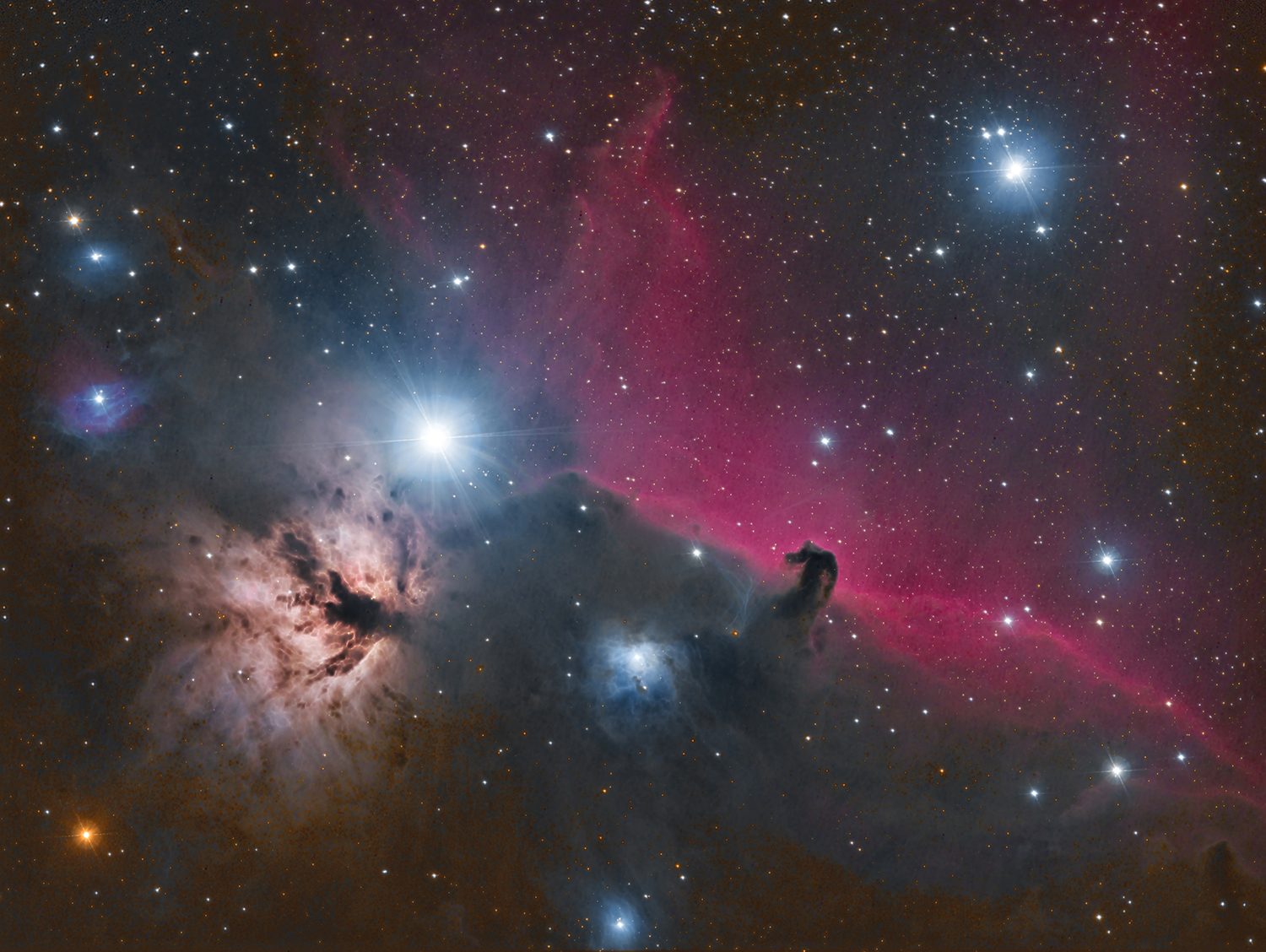 The Horsehead Nebula and the Flame Nebula In the winter constellation Orion, you can see the famous Horsehead Nebula, to the right of centre in this image, and then to the left, the equally famous Flame Nebula This image was collected over several hours and, again, this is a visible light image -- these are the real colours ... just look at that red reflection nebulosity behind the horsehead. Note, also, the star colours .... older, tired stars are reddish or orange, while younger, more vibrant stars are showing as blue or even white, in colour. ☆ ☆ ☆ ☆ ☆ ☆ ☆ ☆ ☆ ◉ The horse-head feature is dark because it is really an opaque dust cloud that lies in front of the bright emission nebula. Like clouds in Earth's atmosphere, this cosmic cloud has assumed a recognizable shape by chance. After many thousands of years, the internal motions of the cloud will surely alter its appearance. ◉ The emission nebula's orange color is caused by electrons recombining with protons to form hydrogen atoms. Toward the lower left of the image is the Flame Nebula, an orange-tinged nebula that also contains intricate filaments of dark dust. ◉ Several prominent reflection nebulas are visible: NGC 2023 is just to the lower left of the Horsehead nebula. Each glows primarily by reflecting the light of their central star. ◉ The bright star, left of centre, is Alnitak, the left-most star in Orion's belt. It is actually a triple star system with its primary star being a hot blue supergiant. Like many star names, Alnitak's etymology is Arabic ... Al Nitak or Alnitah, meaning "the girdle". This region is a favourite for astrophotographers ... it's easy to see why. |
||||||
 The Great Orion Nebula -
Messier 42
Another favourite, found within the constellation Orion, The Hunter. This spectacular nebula is actually naked-eye visible from most northern locations - even within the light dome of cities. The Orion Nebula is one of the most scrutinized and photographed objects in the night sky and is among the most intensely studied celestial features. The nebula has revealed much about the process of how stars and planetary systems are formed from collapsing clouds of gas and dust. ☆ ☆ ☆ ☆ ☆ ☆ ☆ ☆ ☆ ◉ Astronomers have directly observed protoplanetary discs and brown dwarfs within the nebula, intense and turbulent motions of the gas, and the photo-ionizing effects of massive nearby stars in the nebula. ◉ There has been speculation that the Mayans of Central America may have described the nebula within their "Three Hearthstones" creation myth; so, the three would correspond to two stars at the base of Orion, Rigel and Saiph, and another, Alnitak at the tip of the "belt" of the imagined hunter, the vertices of a nearly perfect equilateral triangle with Orion's Sword (including the Orion Nebula) in the middle of the triangle seen as the smudge of smoke from copal incense in a modern myth, or, in (the translation it suggests of) an ancient one, the literal or figurative embers of a fiery creation. ◉ The first published observation of the nebula was by the Jesuit mathematician and astronomer Johann Baptist Cysat of Lucerne in his 1619 monograph on comets. He made comparisons between it and a bright comet seen in 1618 and described how the nebula appeared through his telescope as: " ... one sees how in like manner some stars are compressed into a very narrow space and how round about and between the stars a white light like that of a white cloud is poured out ..." |
||||||
 The Gygnus Wall
High in our summer skies, at northern latitudes, this busy cosmic neighbourhood is another stunner. Dust, light, colours .... all part of our universe. This image was collected, over several hours, using special filters which collect light emitted from ionized Hydrogen, ionized Oxygen and ionized Sulphur. Cygnus is the high-summer constellation also known as The Swan. ☆ ☆ ☆ ☆ ☆ ☆ ☆ ☆ ☆ ◉ The Cygnus Wall is a segment of the North America Nebula (NGC7000) and is the region of the nebula with the most concentrated stellar formation. ◉ The ridge here is approximately 20 light years long and is a huge star forming region. |
||||||
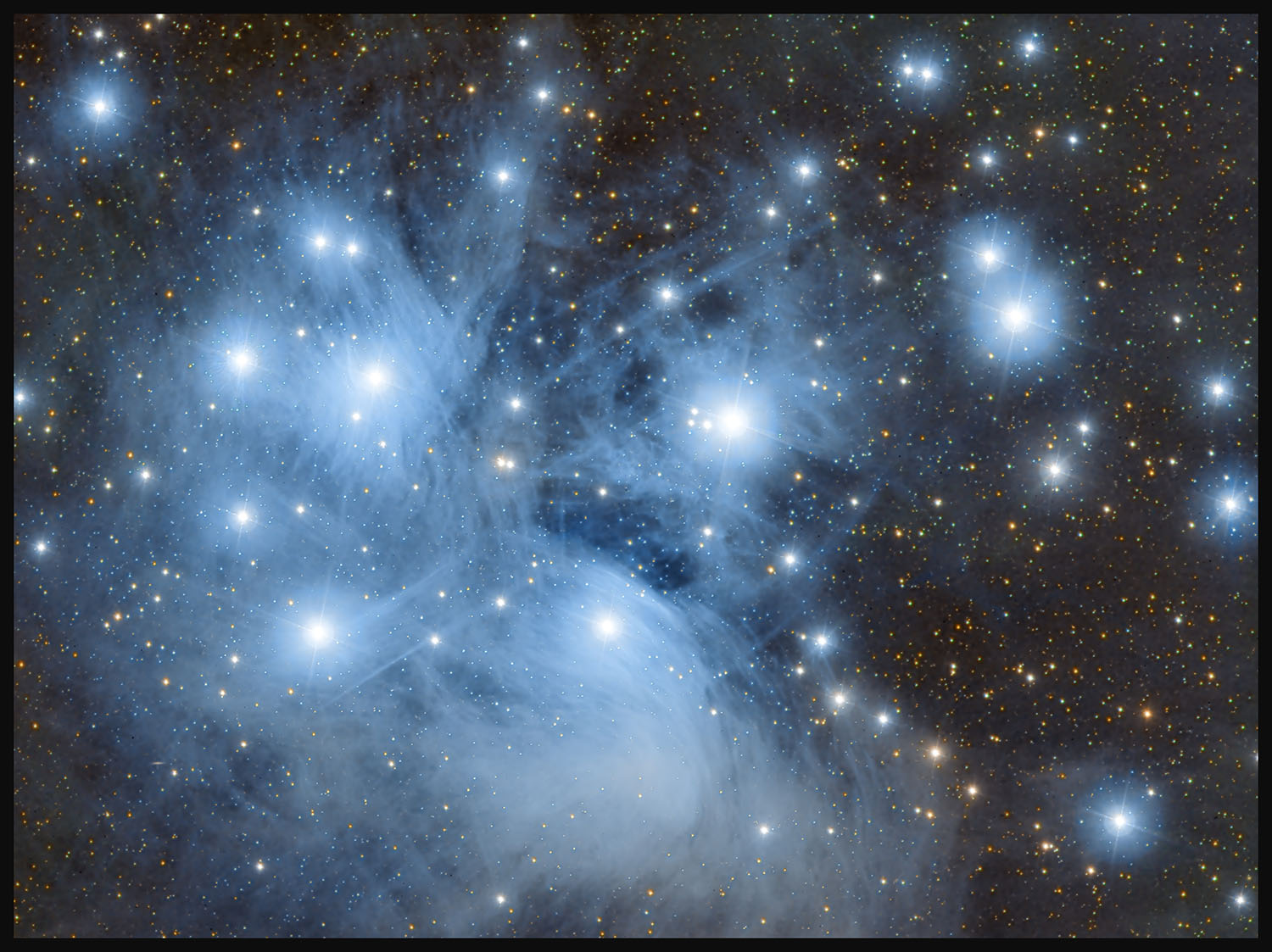 The Pleiades .... The Seven
Sisters ..... Messier 45
Another Fall-Winter favourite. This area of reflection nebulosity was imaged in visible light. The Pleiades, also known as The Seven Sisters, Messier 45 and other names by different cultures, is an asterism and an open star cluster containing middle-aged, hot B-type stars in the north-west of the constellation Taurus. ☆ ☆ ☆ ☆ ☆ ☆ ☆ ☆ ☆ ◉ At a distance of about 444 light years, it is among the nearest star clusters to Earth. ◉ It is the nearest Messier object to Earth, and is the most obvious cluster to the naked eye in the night sky. ◉ The name of the Pleiades comes from Ancient Greek: Πλειάδες. It probably derives from plein ("to sail") because of the cluster's importance in delimiting the sailing season in the Mediterranean Sea: "the season of navigation began with their heliacal rising". However, in mythology the name was used for the Pleiades, seven divine sisters, the name supposedly deriving from that of their mother Pleione and effectively meaning "daughters of Pleione". . |
||||||
'First Light'
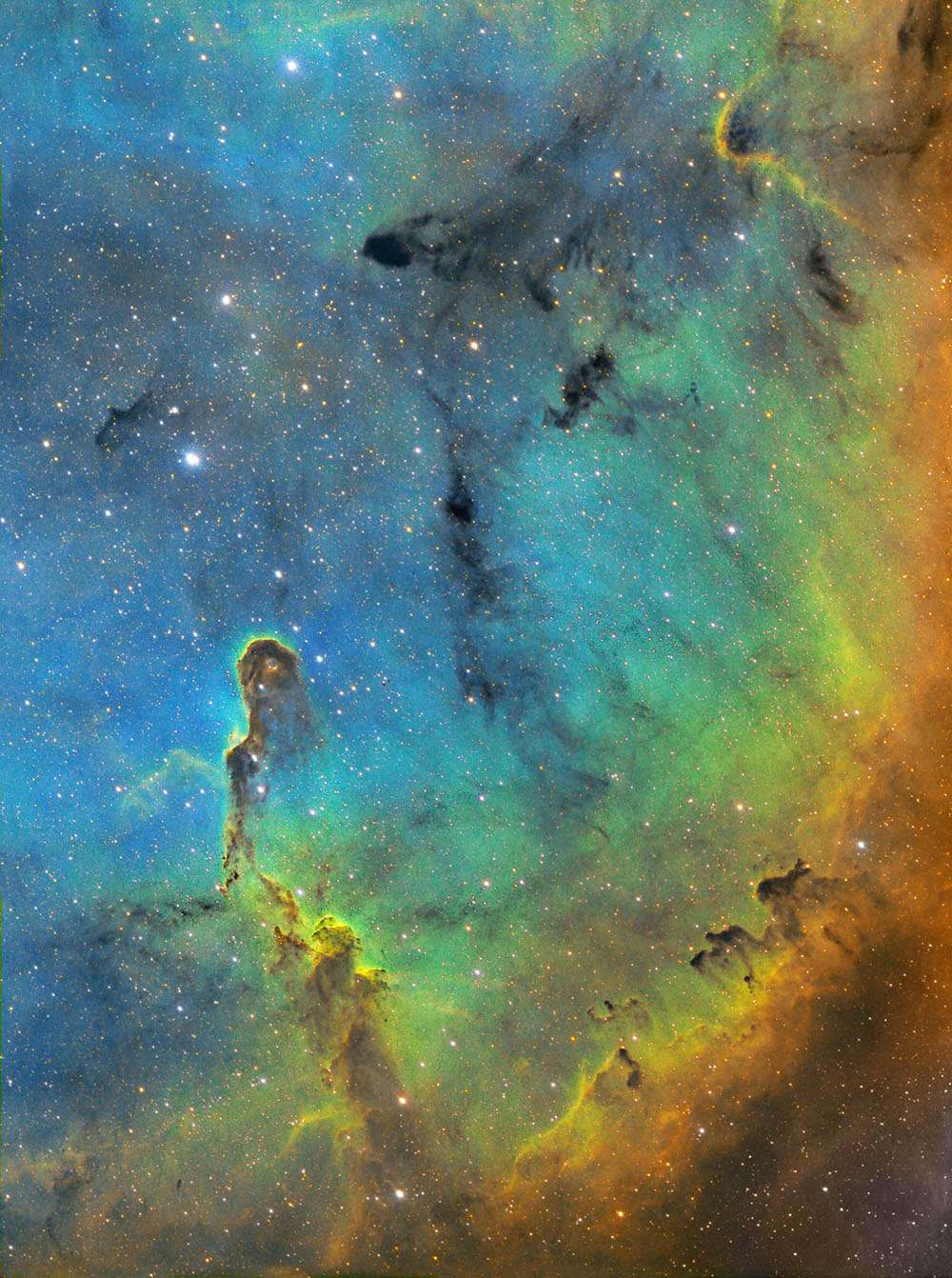 ET at home ... The Elephant
Trunk Nebula and its region
Another late-in-the-year favourite. Images in Hydrogen alpha, Oxygen III and Sulphur II light ... over several hours. This image was actually the 'First Light' for Cassiopeia -- the first official and complete image collected by Cassiopeia, once all of her rigorous testing was concluded. The Elephant's Trunk Nebula is a concentration of interstellar gas and dust within the much larger ionized gas region IC 1396 located in the constellation Cepheus about 2,400 light years away from Earth. The piece of the nebula shown here is the dark, dense globule IC 1396A; it is commonly called the Elephant's Trunk nebula because of its appearance in certain light wavelengths, where there is a dark patch with a bright, sinuous rim. ☆ ☆ ☆ ☆ ☆ ☆ ☆ ☆ ☆ ◉ The Elephant's Trunk Nebula is now thought to be a site of star formation, containing several very young (less than 100,000 yr) stars that were discovered in infrared images in 2003. Two older (but still young, a couple of million years, by the standards of stars, which live for billions of years) stars are present in a small, circular cavity in the head of the globule. Winds from these young stars may have emptied the cavity. ◉ The combined action of the light from the massive star ionizing and compressing the rim of the cloud, and the wind from the young stars shifting gas from the center outward lead to very high compression in the Elephant's Trunk Nebula. This pressure has triggered the current generation of protostars.
|
||||||
 The Pacman Nebula - NGC281
Colloquially, NGC281 is known as the Pacman Nebula, because of its resemblance to the video game character. NGC281 is a bright emission nebula in the northern constellation Cassiopeia, which is in our Milky Way's Perseus Spiral Arm. ☆ ☆ ☆ ☆ ☆ ☆ ☆ ☆ ☆ ◉ This deep space object (DSO) is slightly smaller than a full Moon. It is also associated with the open cluster of stars catalogued as IC1590. ◉ This nebula was discovered in 1883 by Edward Emerson Barnard, an eminent American astronomer. ◉ In the 1880s, philanthropist and businessman Hulbert Harrington Warner offered $200 per discovery of a new comet. Barnard, who grew up impoverished in Tennessee, discovered a total of five, in the years immediately following his marriage. He used the money to build a house for himself and his wife. |
||||||
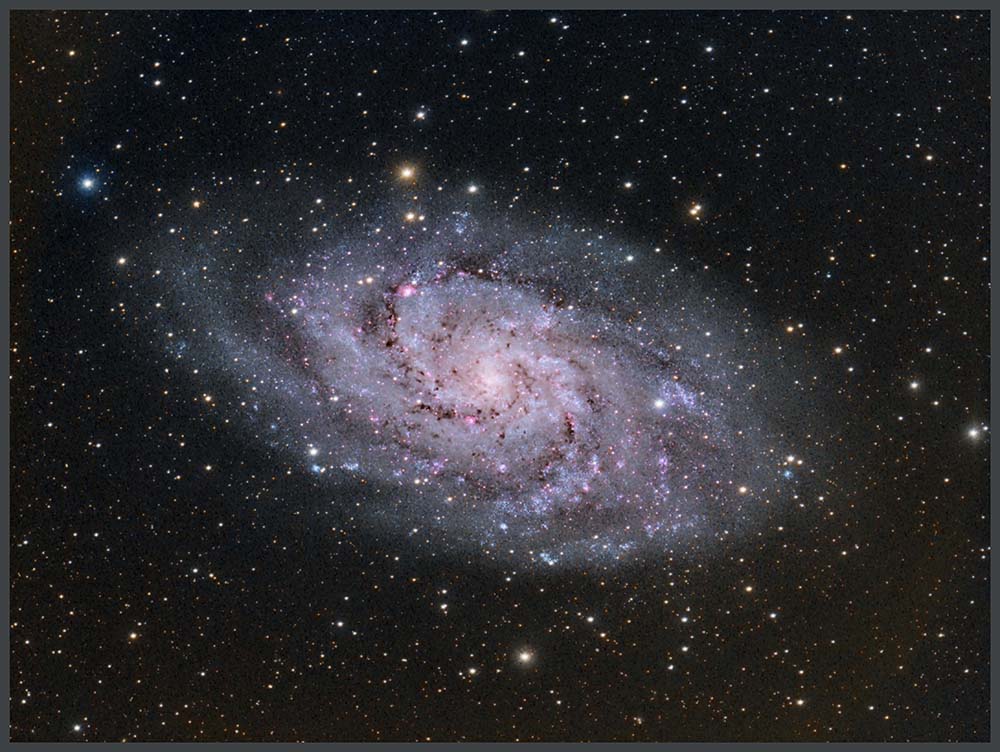 The Triangulum Galaxy -
Messier 33
The Triangulum Galaxy is a spiral galaxy 2.73 million light-years from Earth in the constellation Triangulum. It can be seen with 20-20 vision from a dark sky site and it s likely the farthest permanent entity visible without magnification. It is catalogued as Messier 33 or NGC (New General Catalogue) 598. With the D25 isophotal diameter of 18.74 kiloparsecs (61,100 light-years), the Triangulum Galaxy is the third-largest member of the Local Group of galaxies, behind the Andromeda Galaxy and the Milky Way. It is one of the most distant permanent objects that can be viewed with the naked eye. The galaxy is the smallest spiral galaxy in the Local Group (although the smaller Large and Small Magellanic Clouds may have been spirals before their encounters with the Milky Way), and is believed to be a satellite of the Andromeda Galaxy or on its rebound into the latter due to their interactions, velocities, and proximity to one another in the night sky. It also has an H II nucleus. ☆ ☆ ☆ ☆ ☆ ☆ ☆ ☆ ☆ ◉ The Triangulum Galaxy's diameter is approx. 61,100 light-years. ◉ It is the third-largest member of the Local Group of galaxies, behind the Andromeda Galaxy (see image above, and the Milky Way, our home galaxy). ◉ It is believed to be a satellite of the Andromeda Galaxy or on its rebound into the latter due to their interactions, velocities, and proximity to one another in the night sky. ◉ It also has an H II nucleus. The HII presence/activity can be seen in the above image as the reddish clusters visible in the spiral arms and also bu the faint reddish hue over the bright core. |
||||||
The Rosette Nebula - Caldwell
49
In 'false colour' - Narrowband filtered light There is a cluster of stars in the centre of this nebula, which is known as NGC2244. It is these stars which provide the energy to make this nebula 'glow' for us. The entire region is a strong source of light in the red spectral lines, hence its strong signal for Hydrogen-alpha astronomy. It is also a stellar nursery. This late-Autumn, Winter cosmic citizen is about 5.200 light years from Earth. If you are familiar with the constellation Orion -- a favourite -- go to the top two stars in Orion (Betelgeuse and Bellatrix) and then go to the left about the same distance those stars are from each other ... and you will be looking at the region of the sky where the Rosette Nebula is found. The Rosette Nebula is the largest 'blossom' in any garden ... it is approx. 135 light years in diameter. ☆ ☆ ☆ ☆ ☆ ☆ ☆ ☆ ☆ ◉ This DSO (Deep Space Object) was imaged in narrowband ... which is not normal light, for human perception. In this particular set of data .... several hours worth of exposure with a specialized astro camera ... the light captured is from ionized Hydrogen (wavelength 656nm) , ionized Oxygen (two spectral lines, wavelengths 496nm and 501nm) and ionized Sulpher (wavelength 672nm), with respective bandwidths of 3.5nm, 4nm and4 nm. The camera images in Black & White only, and the image date from these ultra-specialized filters is processed with astro software. During processing, the Ha, OIII and SII data can be ascribed certain 'colour channels' -- which produce a final result with a certain colour palette. If you then reprocess the same data but ascribe the date to different 'colour channels', the final results can be completely different. The main image, above, is described as combination of HSS -- Hydrogen Sulpher Sulper Below, are four other combinations, from the same set of data, processed differently.
|
||||||
The Soul Nebula - Westerhout
5
( Also: Sharpless 2-199 and LBN 667 ) 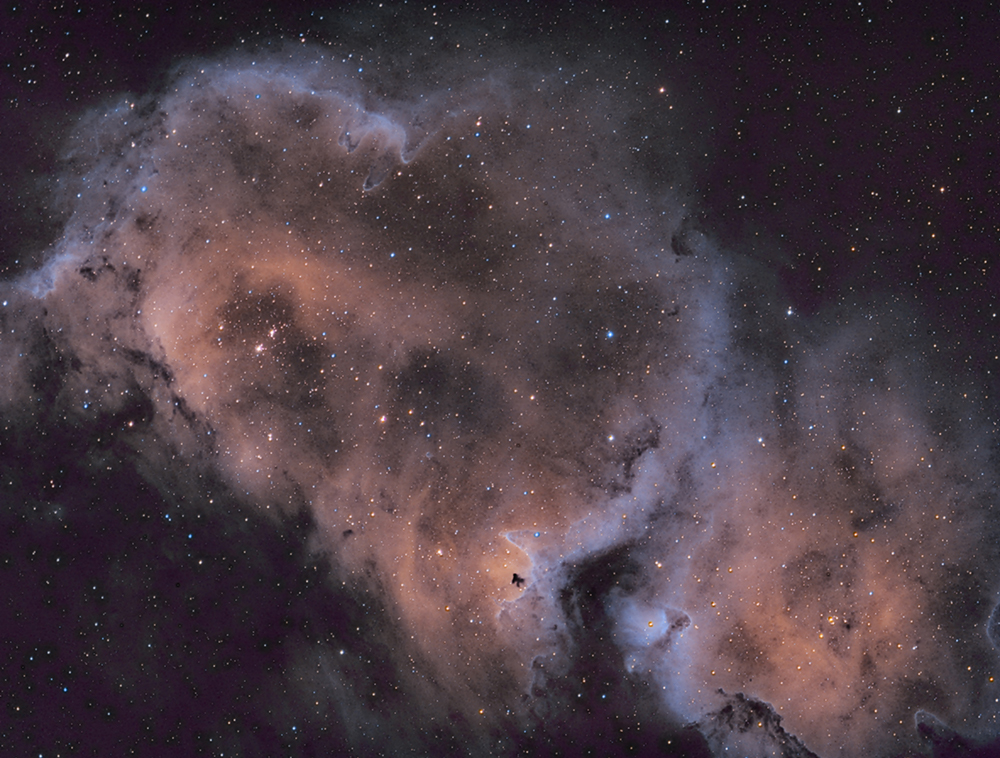 The Soul Nebula is a massive
star-formation region within the constellation
Cassiopeia.
Those large cavities visible in this image were created by radiation and winds from the region's massive stars. According to the 'triggered star formation theory', the creation of these cavities pushed gasses together causing the creation of successive generations of new stars. (More on this subject here: STAR FORMATION ) The Soul Nebula, most of which is in this image, is very close to the Heart Nebula -- which is really closely shaped like a heart. With a wider field of view, astrophotographers can capture both of these Deep Space Objects (DSOs) in the same image. Together, they are poetically referred to as 'The Heart and Soul'. There is an image of the Heart Nebula elsewhere on our companion astro website, here: http://galileostelescope.net/ This image is a total exposure of several hours, in light from ionized hydrogen, from ionized sulphur and ionized oxygen. ☆ ☆ ☆ ☆ ☆ ☆ ☆ ☆ ☆ ◉ Here is a link to a 6-min Wikipedia video on 'The W5 Stellar Blast Furnace' https://en.wikipedia.org/wiki/File:The_W5_Stellar_Blast_Furnace.ogv ◉ Many stars in this region are thought to be a few million years old. Our Sun, by comparison, is almost 5 billion years old. ◉ The Soul Nebula is about 100 light years in length. ◉ The Soul Nebula is about 5x the size of a full Moon, in length. |
||||||
| The Crescent Nebula - plus the faint Soap Bubble Nebula ( NGC 688 and PN G075.5+01.7) 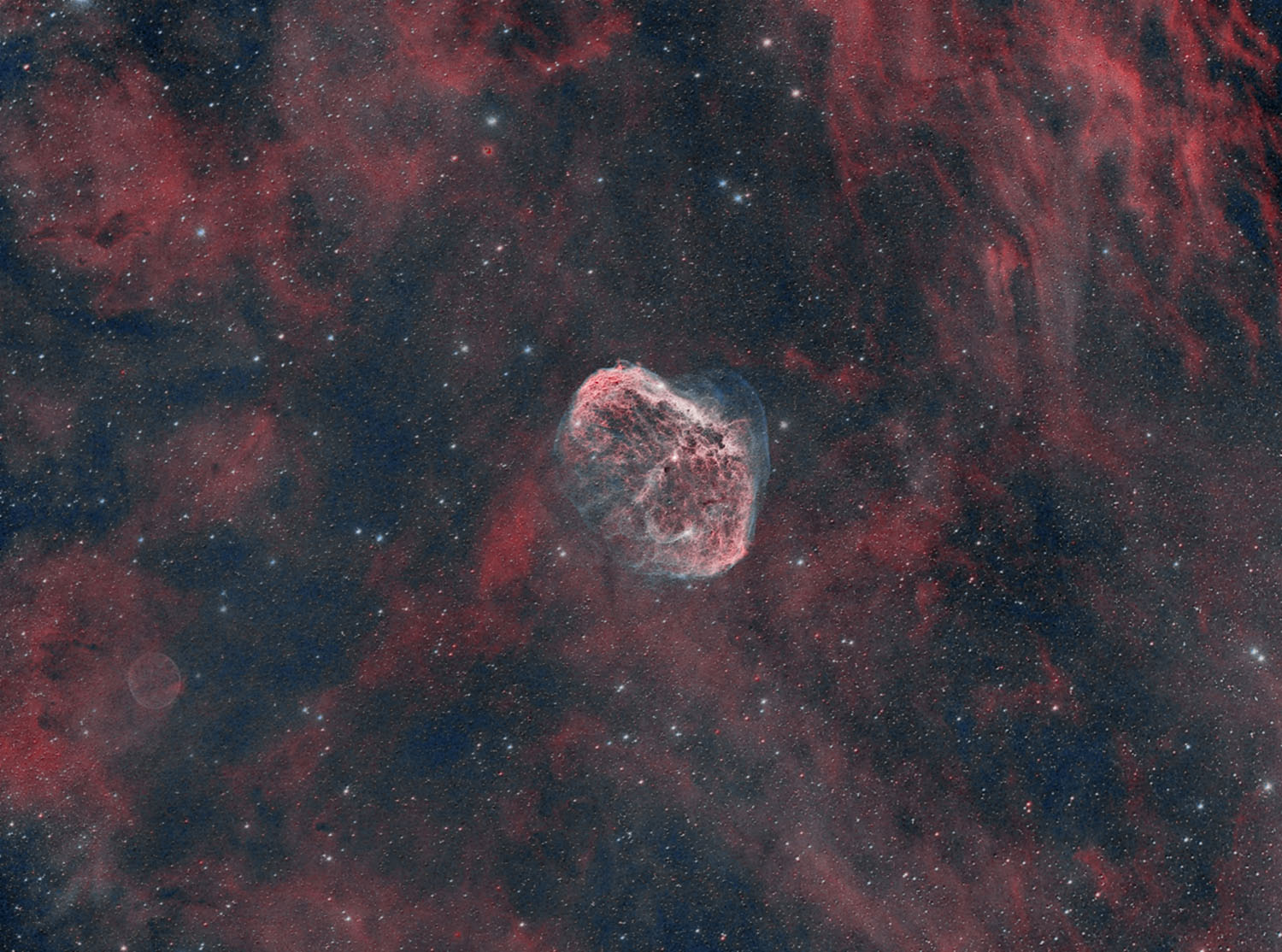 HERE IS
an image of the popular Crescent Nebula ...
it rather looks like a floating brain in
space ...
This emission nebula is
found in the high-in-summer constellation
Cygnus, which is a rich source of astro
photography targets ... it is right smack in
the middle of our Milky Way galaxy
☆ ☆ ☆ ☆ ☆ ☆ ☆ ☆ ☆ The Crescent, sadly, is
moving to the end of its stellar life and
will eventually finish with a spectacular
super nova explosion.
Now, a couple of years ago,
a very, very faint Deep Sky Object (DSO) was
discovered near to the Crescent. You can see
it, to the lower left.
This new discovery, likely
a a so-called planetary nebula, is believed
to be the final shroud of a low-mass,
Sun-like star. It is headed to becoming a
white dwarf. Again, sadly, an
end-of-stellar-life event.
This second object is
called the Soap Bubble Nebula and can be
seen, faintly, to the lower left corner of
this image.
Imaged in June 2023, from
atop the Blue Mountains, in H-alpha, Oxygen
III and Sulphur II light.
This particular iteration
of these data is processed in Ha + OIII +
OIII ... if I mix in the SII, I lose the
Soap Bubble.
The Soap
Bubble is actually a
planetary nebula (which
has nothing to do with
planets, by the way),
which was discovered in
2007.Coincidentally, and unknown to me at the time, some of this data was collected on the 15th anniversary of amateur astronomer Dave Jurasevich's actual discovery. Jurasevich, while being the Director of the Mt. Wilson Observatory, outside Los Angeles, California, used a (serious) amateur telescope in his discovery. ◉ The unique brain-like shape of this object is formed by the fast stellar wind from the Wolf-Rayet star WR 136 (HD 192163) colliding with and energizing the slower moving wind ejected by the star when it became a red giant around 250,000 to 400,000 years ago |
||||||
Messier 101 (Pinwheel Galaxy) & Supernova SN2023ixf (This supernova is -- pretty well -- the brightest star in this galaxy.) 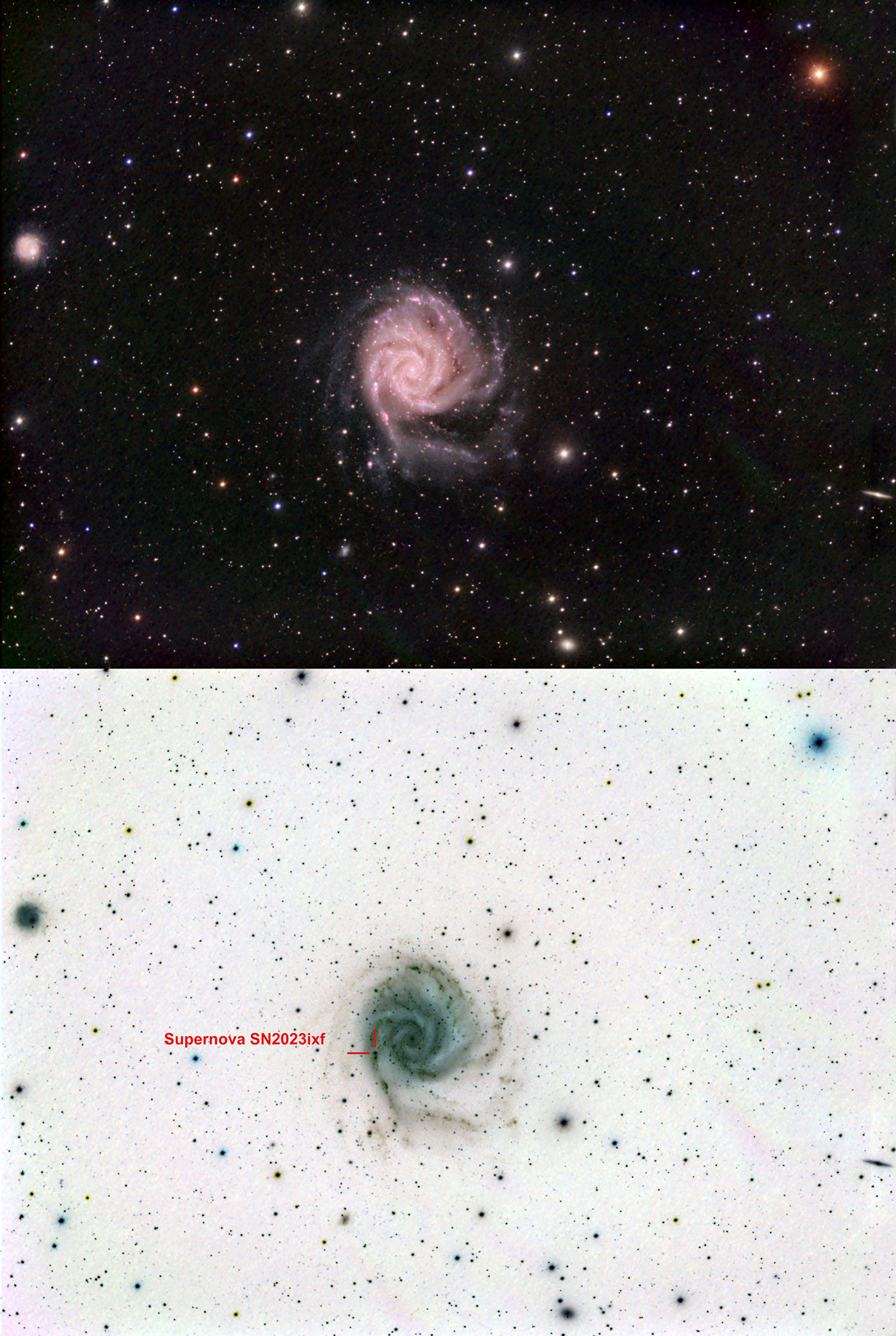 The Pinwheel Galaxy (also known as Messier 101, M101 or NGC 5457) is a face-on spiral galaxy 21 million light-years (6.4 megaparsecs) away from Earth in the constellation Ursa Major. It was discovered by Pierre Méchain in 1781 and was communicated that year to Charles Messier, who verified its position for inclusion in the Messier Catalogue as one of its final entries. This stunning galaxy is a favourite with astrophotographers. This image represents about 10.5 hours of exposure in R G B & H-alpha light, starting May 20, 2023. Now, this date is significant -- because unknown to Connie and I at the time (we were both at our observatory at this time) a star had gone 'supernova' in this galaxy less than 24 hours earlier. So, we collected several hours of imaging date on this galaxy without knowing that we had also image a star blowing up. In fact, we were collecting image data on it at the same time as the Zwicky Transient Facility (ZTF), in California, was actually confirming the supernova. What are the chances of this ....? Astronomical! Think about what a supernova means .... that star likely had planets around it before it exploded .... ☆ ☆ ☆ ☆ ☆ ☆ ☆ ☆ ☆ ◉ Supernova hunter Koichi Itagaki, from Yamagata, Japan, first spotted the explosion, which was confirmed the following day (May 20) by telescopes of the Zwicky Transient Facility (ZTF) in California. |
||||||
The Great Hercules Star Cluster ( Messier 13 - The most magnificent star cluster in the northern hemisphere. )  Messier 13 or M13, also designated NGC 6205 and sometimes called the Great Globular Cluster in Hercules or the Hercules Globular Cluster, is a globular cluster of several hundred thousand stars in the constellation of Hercules. Messier 13 was discovered by Edmond Halley in 1714,and cataloged by Charles Messier on June 1, 1764, into his list of objects not to mistake for comets. Messier's list, including Messier 13, eventually became known as the Messier catalog. It is located at right ascension 16h 41.7m, declination +36° 28'. Messier 13 is often described by astronomers as the most magnificent globular cluster visible to northern observers. About one third of the way from Vega to Arcturus, four bright stars in Herculēs form the Keystone asterism, the broad torso of the hero. M13 can be seen in this asterism 2⁄3 of the way north (by west) from Zeta to Eta Herculis. With an apparent magnitude of 5.8, Messier 13 may be visible to the naked eye with averted vision on dark nights. Messier 13 is prominent in traditional binoculars as a bright, round patch of light. Its diameter is about 23 arcminutes (almost the size of a full Moon) and it is readily viewable in small telescopes. At least four inches of telescope aperture resolves stars in Messier 13's outer extent as small pinpoints of light. However, only larger telescopes resolve stars further into the center of the cluster. The cluster is visible throughout the year from latitudes greater than 36 degrees north, with the longest visibility during Northern Hemisphere spring and summer. About 145 light-years in diameter, M13 is composed of several hundred thousand stars, with estimates varying from around 300,000 to over half a million. The brightest star in the cluster is a red giant, the variable star V11, also known as V1554 Herculis, with an apparent visual magnitude of 11.95. M13 is 22,200–25,000 light-years away from Earth, and the globular cluster is one of over one hundred that orbit the center of the Milky Way.[17][18] ☆ ☆ ☆ ☆ ☆ ☆ ☆ ☆ ☆ ◉ Nearby to Messier 13 is NGC 6207, a 12th-magnitude edge-on galaxy that lies 28 arcminutes directly northeast. You can see NGC 6207 here, just below the Hercules cluster at about the 5.30 o'clock position ... about halfway from the star cluster to the bottom of this image. It looks like a small, fuzzy cigar-shape of light. ◉ Also, a tiny, tiny galaxy, IC 4617, lies between NGC 6207 and the star cluster. Again, it is tiny .... you can see it ... go to the halfway point between the centre of the star cluster and NGC 6207 ... then go up, slightly, and to the right. It has the same cigar shape as NGC 6207 and has the same alignment. |
||||||
The Eagle Nebula - The Star Queen - Messier 16 - The Pillars of Creation ( The Hubble Space Telescope has been here, too ...) 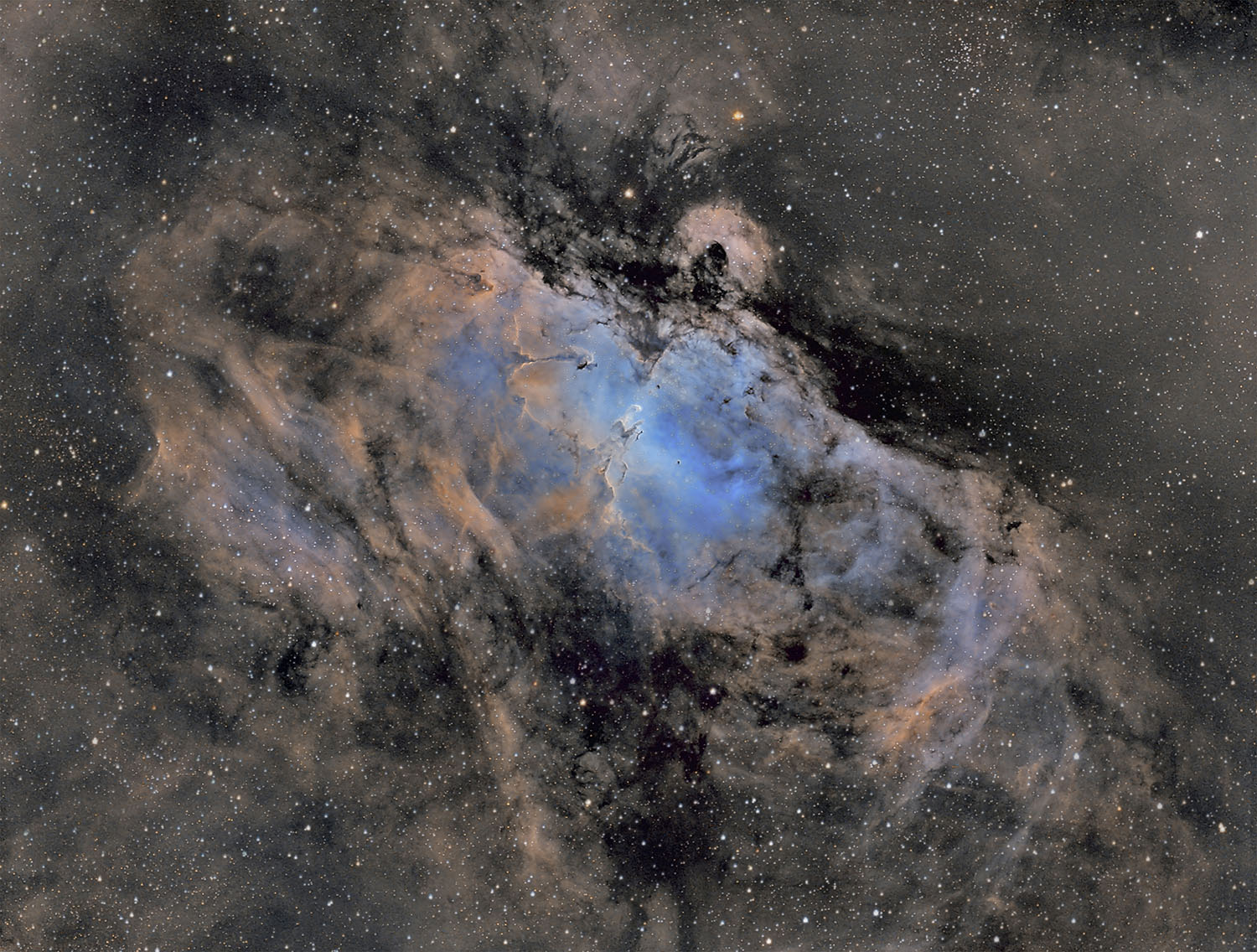 The Eagle Nebula (catalogued as
Messier 16 or M16, and as NGC 6611, and also
known as the Star Queen Nebula) is a young open
cluster of stars in the constellation Serpens.
It was discovered by Jean-Philippe de Cheseaux in 1745–46. Both the "Eagle" and the "Star Queen" refer to visual impressions of the dark silhouette near the center of the nebula. This is the same area made famous as the "Pillars of Creation" imaged by the Hubble Space Telescope. The nebula contains several active star-forming gas and dust regions, including the aforementioned Pillars of Creation. The Eagle Nebula lies in the Sagittarius Arm of the Milky Way. The Eagle Nebula is part of a huge diffuse emission nebula, or H II region, which is catalogued as IC 4703. This region of active current star formation is about 5700 light-years distant. A spire of gas that can be seen coming off the nebula in the northeastern part is approximately 9.5 light-years or about 90 trillion kilometers long. The cluster associated with the nebula has approximately 8100 stars, which are mostly concentrated in a gap in the molecular cloud to the north-west of the Pillars. The brightest star (HD 168076) has an apparent magnitude of +8.24, easily visible with good binoculars. It is actually a binary star formed of an O3.5V star plus an O7.5V companion. This star has a mass of roughly 80 solar masses, and a luminosity up to 1 million times that of the Sun. The cluster's age has been estimated to be 1–2 million years. ☆ ☆ ☆ ☆ ☆ ☆ ☆ ☆ ☆ Two images of this nebula are presented here. The first, above, is about 6.5-hours of exposure in H-alpha, OIII, SII, R, G, B and UV-IR Cut-L frequencies of light. ◉ ABOVE: Process in SHO - the Hubble Palette, with RGB stars blended with PixInsight. All data integrated here. ◉ BELOW: Processed in Hydrogen-alpha light only, Approx. two hours of exposure. ◉ DATA COLLECTION: It took four years to collect this data for this image, starting in the summer of 2019. A host of issues repeatedly scuppered the work here.
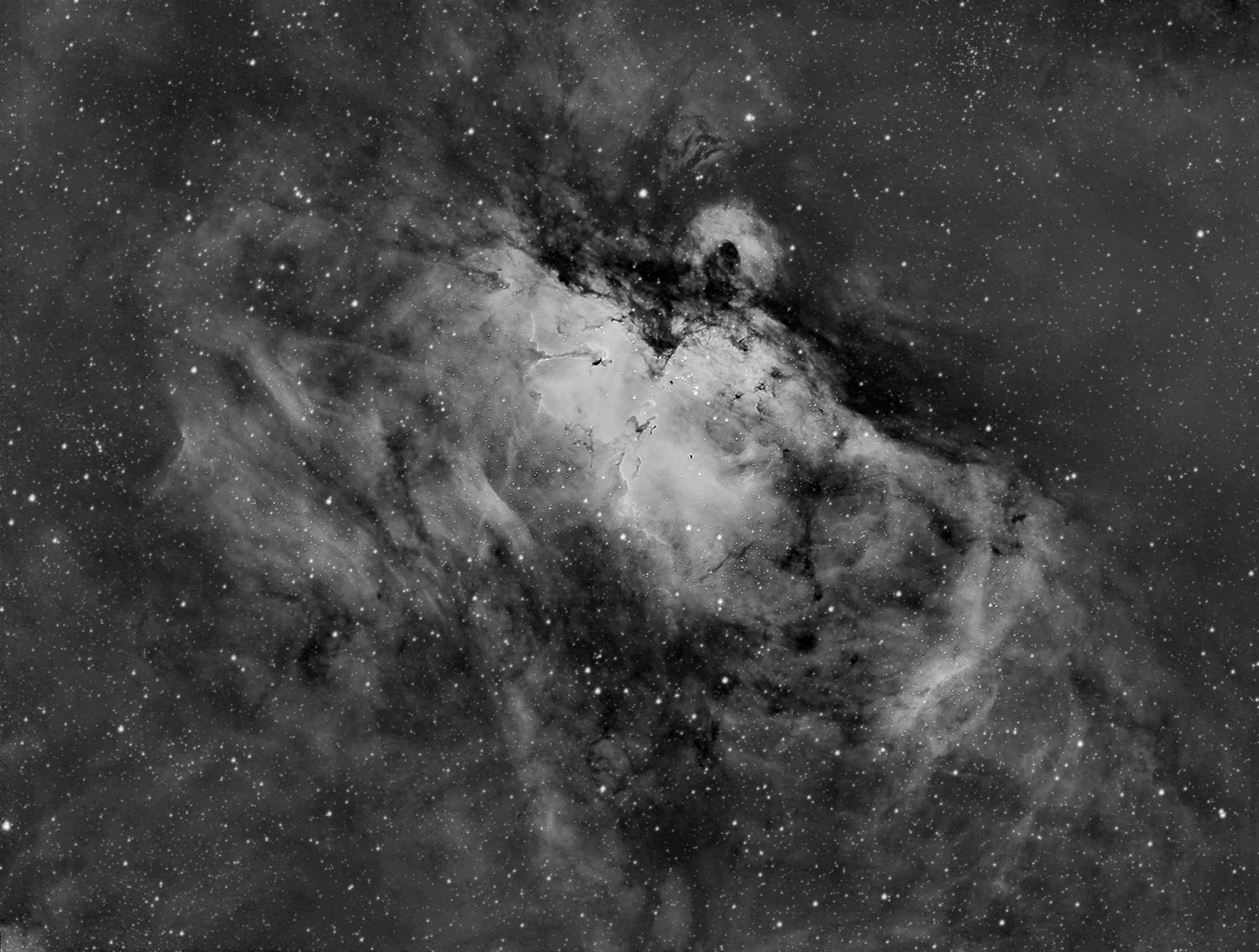 |
||||||
A typical group at the CAO.
All total nerds ... the Big Bang Theory has nothing on these folks.
A visitor this day, red arrow, was regular Dr. Sara Seager, the Class of 1941 Professor of Planetary Science, Professor of Physics and Professor of Aeronautics and Astronautics at the Massachusetts Institute of Technology. She is currently lead on the TESS project, the Transiting Exoplanet Survey Satellite - looking for other planets outside of our solar system. Her hubby, behind her, happened to mention recently that they may be going to Australia for another rocket launch .... it seems Sara is dropping a probe into Venus. Go figure, eh ? On the extreme left is Dr. Ralph Chou, current Director of the Carr Astronomical Observatory. To the extreme left is a corner the main, communal living building. It's two storeys and, among other assets, has a large lecture room downstairs.

The
South end of the Geoff Brown Observatory, with the
roof rolling off to the North ... getting ready to
touch the cosmos.
This
is the Warm Room, inside the Geoff Brown
Observatory. The only thing it doesn't have is a
kitchen sink -- but that's steps away at the main
residence building....

Don in his dome .....
Next-door neighbour Don, packing things up after a long night in his observatory. That is an impressive Esprit 120 sitting on his mount.
The nice thing about working this way, is that once the instrument is running properly on target, gathering data, you can retire to the main building and grab a nap in one of the bedrooms .... and let your computer system run everything automatically .... even 'Park' your instrument when it is finished its data collection.
The always-lovely Bruce Trail runs by the CAO's property.
It's easy to go for hikes, when one of the finest walking trails in the country
is literally steps from where your are. You can see
a group of Bruce Trail hikers in the middle of this image.
It can get busy at the CAO .... you can see a couple of camper-trailers onsite
and lots of cars. That is the equipment garage, to the left .. and you can see some
of the smaller observatories to the back. This view is looking to the South.
Looking to the north-west ... from a drone. You can see the camping area to the right side (north side) of the main building. The larger Geoff Brown Observatory has its roof paritally open ... the the left of it, you can see a small roll-off roof observatory and a marque-style structure, where Dr. Sara Seager was to present on the TESS (Transiting Exoplanet Survey Satellite) project. In lower centre, you can see some equipment being set up on the Observing Pad. At the lower edge, right of centre, the small Tony Horvatin Observatory is starting to open up ... you can see its shutter is already open.
That valley to the back is the Beaver Valley ... and you can see Georgian Bay at the top, right corner.
The north side of the main building has a camping area -- with its own campfire spot.

Here is what the large, communal kitchen looks like ... notice the large painting
of Mars on the wall.
Our (larger) group also provides educational events at the David Dunlap Observatory, formerly part of the University of Toronto.
anada's largest optical telescope is hidden within this dome. The DDO is a national treasure ... for lots of reasons.
---------------------------------------------------
We have also hosted education events within the DDOs Administration Building, seen below.
Group shot .. on the steps of the Administration Building at the David Dunlap Observatory.
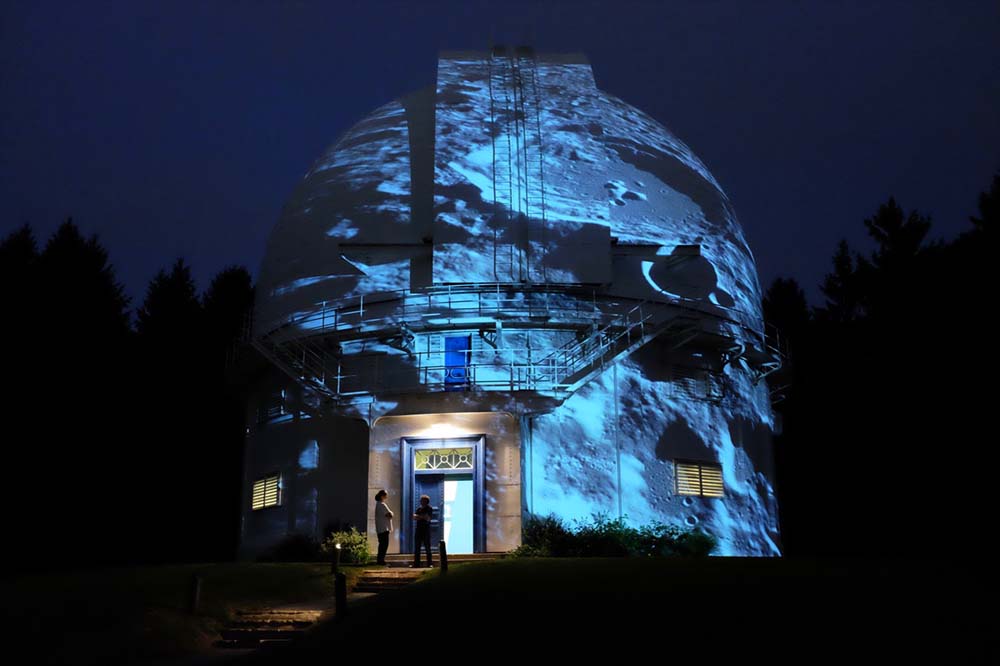
When we run programs at the David Dunlap Observatory, sometimes
a moving lunar landscape is projected onto the outside of the DDO's huge white
dome. The projector is located in a window on the 2nd floor of the
nearby Administration Building.
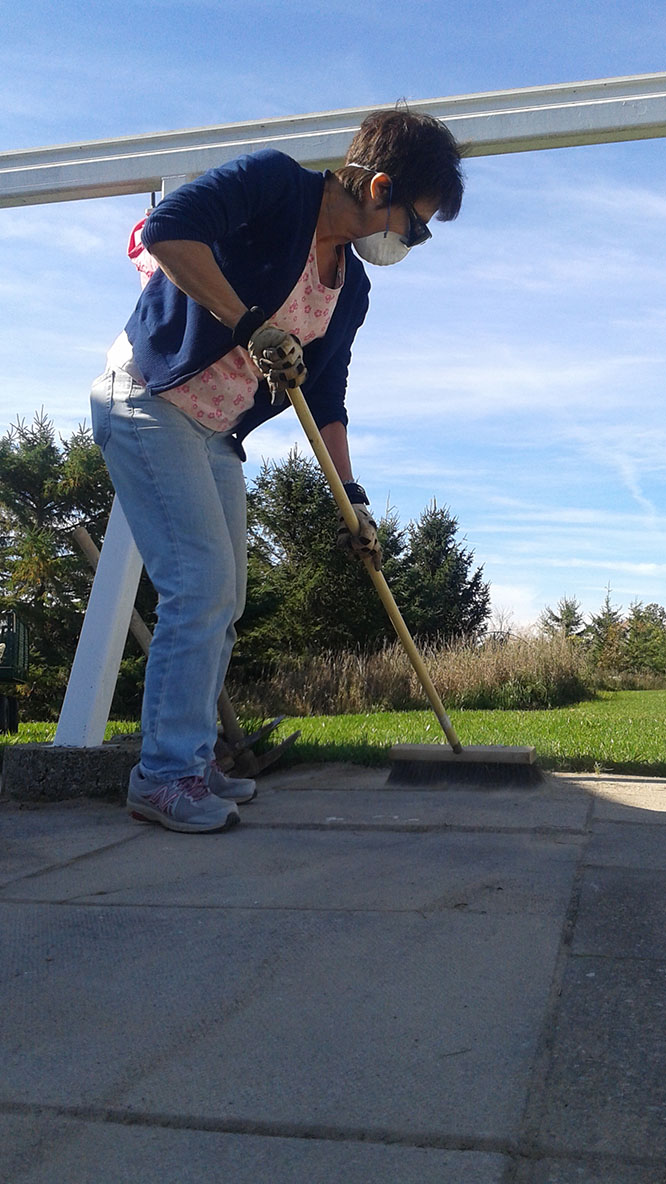

Connie (we
met in Physics class) hard at work, during one
of the many work parties ....... and then taking some
well-deserved time off
atop the Blue Mountains.
atop the Blue Mountains.
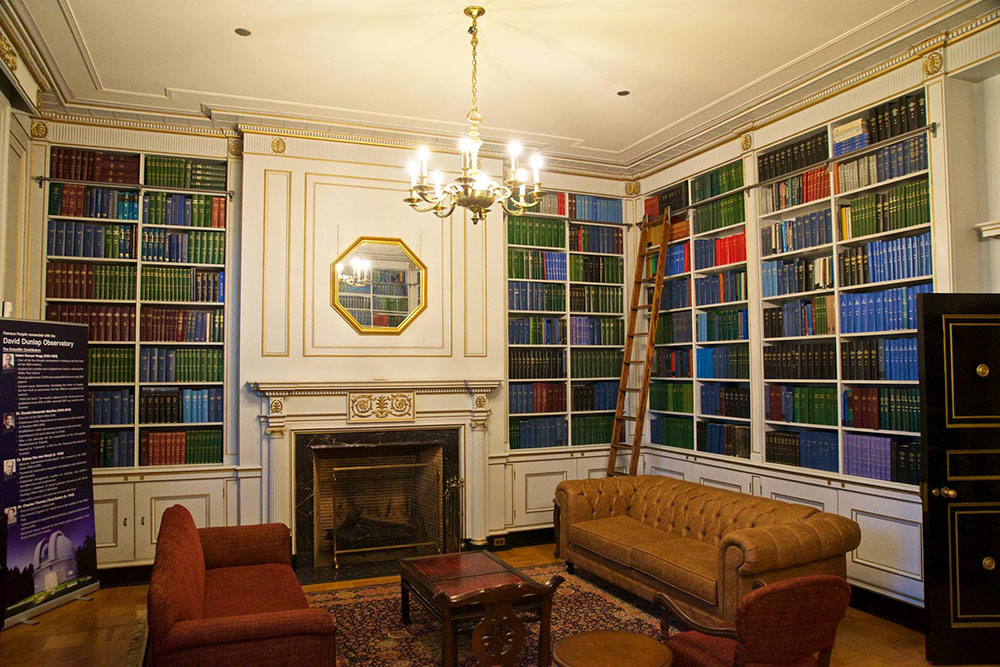
The breathtakingly
spectacular library, in the DDO's Administration
Building.

The trussed optical tube assembly that is the workhorse of the DDO. The instrument weighs
27 tons ... and you can work from either end of it, depending on how you set it up.........
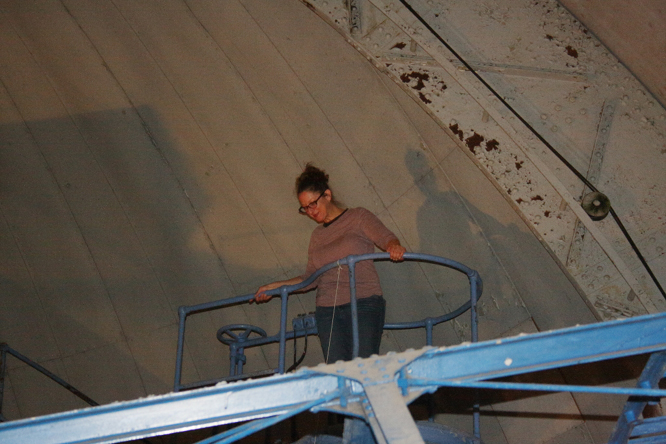
... if you are
running it as a Newtonian, you're up here .....
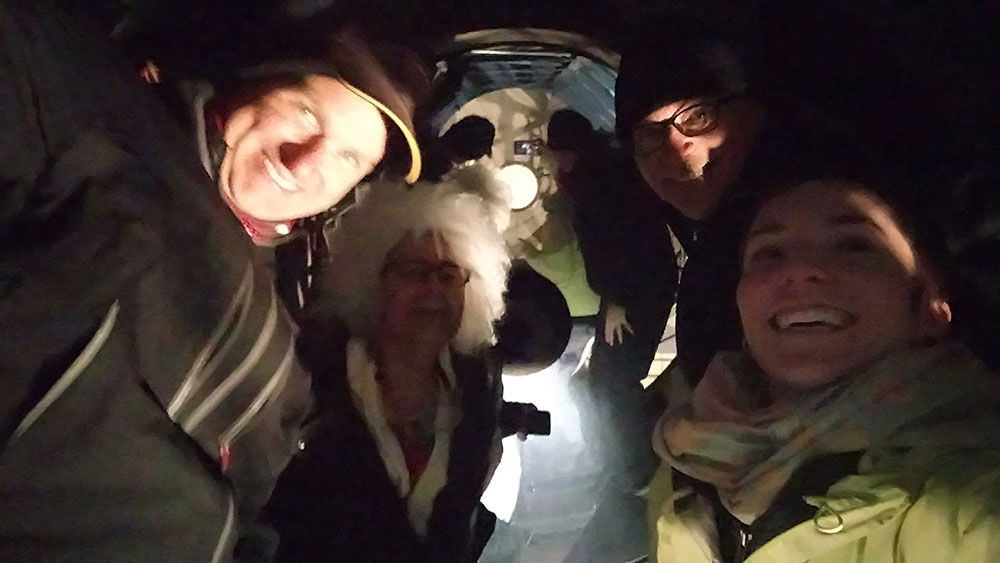
... and sometimes you have to get inside it .... from left, Lachlan McDonald, an astronomer from Australia, Chris Vaughan astronomer and Earth scientist, yours truly, and Jenna Hinds, Executive Director of the Royal Astronomical Society of Canada. We are all inside the actual DDO telescope, down at the bottom where you can see the huge mirror behind us .... Chris was teaching us how to open up the baffles that protect the mirror, to prepare the instrument for use.

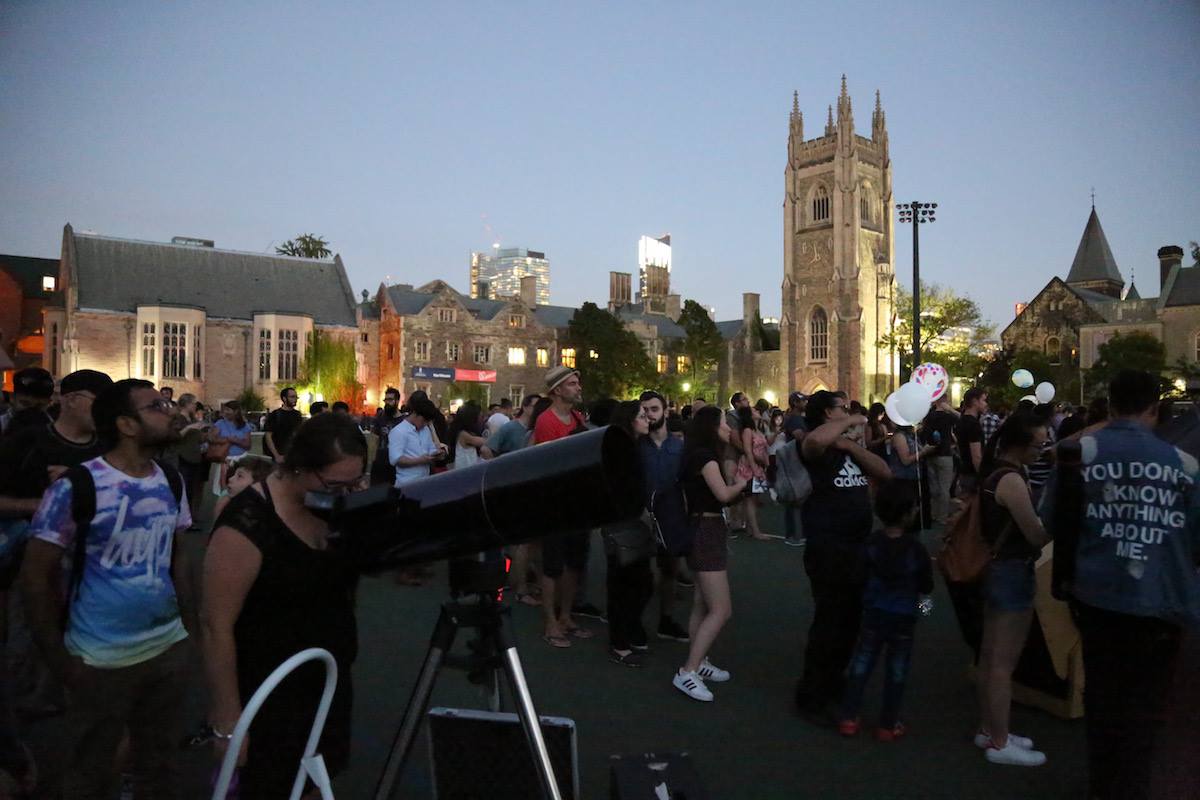
University of Toronto star party .... we ... (the Royal Astronomical Society of Canada, that is ... ) were mobbed. Education Outreach to the student body with portable telescopes, in co-ordination with UofT's Dunlap Institute of Astrophysics and Astronomy. This extremely busy summer evening we had multiple planets above us and all easily visible. With the right equipment, they are actually easy to see -- and even see some landscape detail on -- despite the intense light dome of the city.
This was fun ... a long time ago, Connie and I both took a course of Planetary Geology here, within our respective paths of study (her's Arts, mine the Sciences).

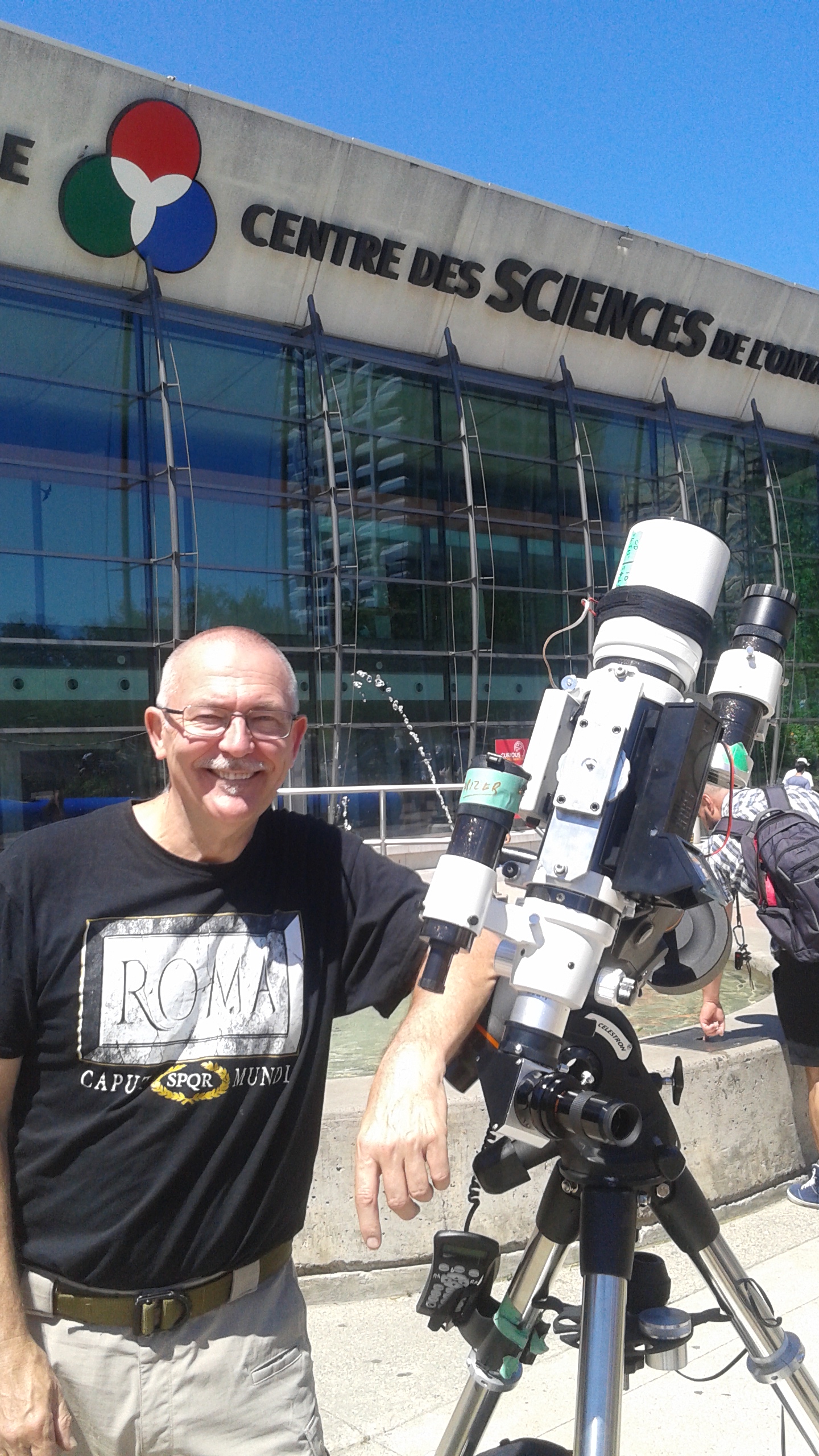
We ... (the Royal Astronomical Society of Canada, that is ... ) regularly host astro-related talks, presentations, planetary parties and even solar-viewing sessions with/for the Ontario Science Centre, which is what this image is from. Our 'official' mailing address is actually here, at the OSC. You can't see it in this photo, but there is a correct solar filter on this instrument. Never ever look at the Sun without proper filtering, you can severely injure your eyes.
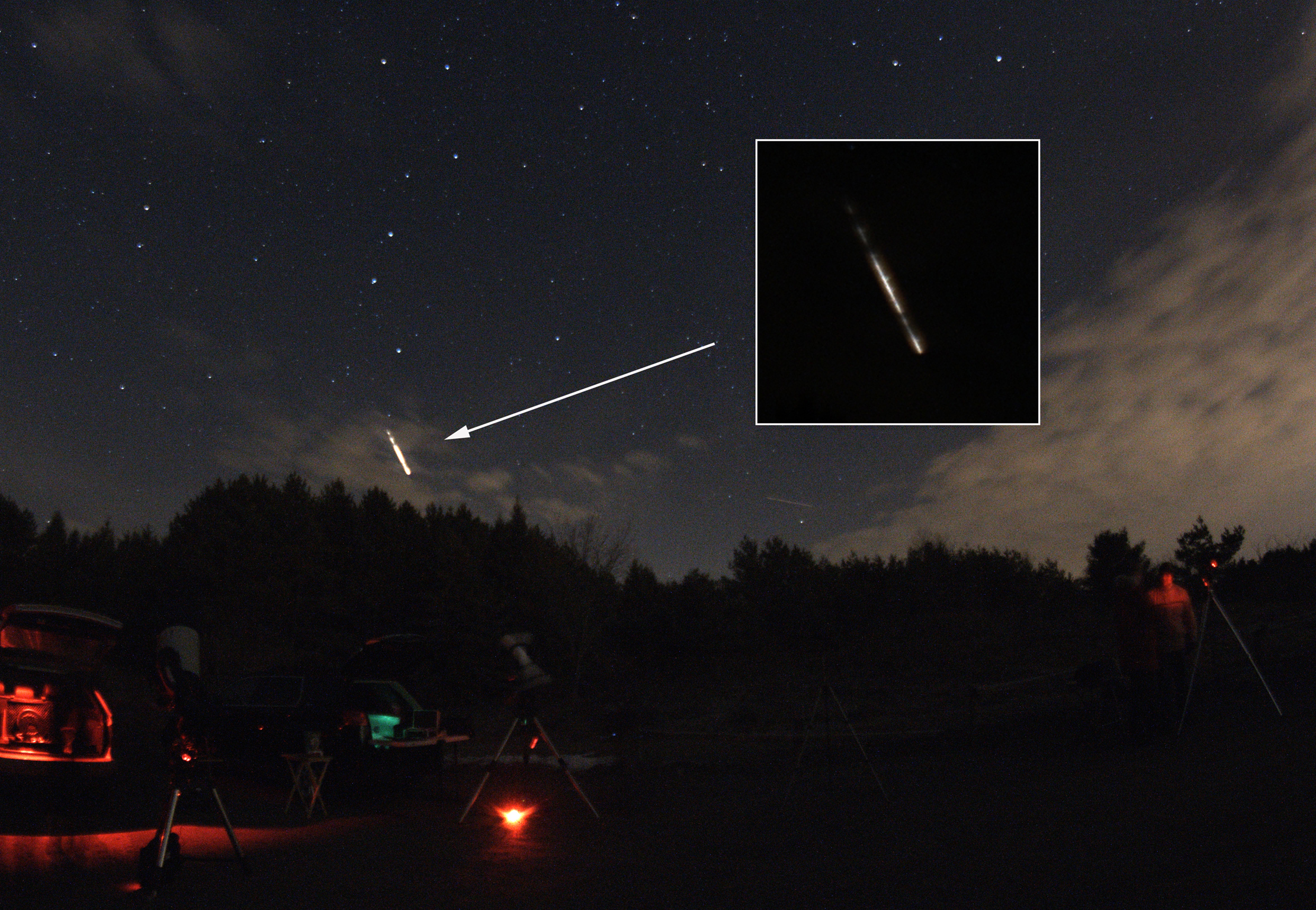
Talk about luck ... this image was a 'scene setter' photo for a report on a Public Education Outreach Star Party, in a darker sky area north of Bowmanville, Ontario. The image was 'photo bombed' by a cosmic visitor -- a meteor -- burning up through the Earth's atmosphere as it arrived ... what are the chances of that???
You can easily see the Big Dipper directly above this fireball and, in the upper left corner, Polaris, the North Star.
Because this photo had all of the astronomical metadata with it ... plus other data that can easily be deduced this image, this photo became part of a published report with the American Meteor Society.
Here is that report: CLICK HERE
 Our newest observatory at the CAO - The Dunlap Instutute for Astronomy and Astrophysics, at the University of Toronto Click here for DUNLAP INSTITUTE |
|||
| The
Dunlap Institute for Astronomy and Astrophysics,
part of the University of Toronto, is the newest
member of the CAO family. In late 2023, the
Dunlap Institute began erection of their
clamshell-style observatory with us. The UofT's observatory is expected to host its first undergrad and graduate students during the Winter semester of 2024. |
|||
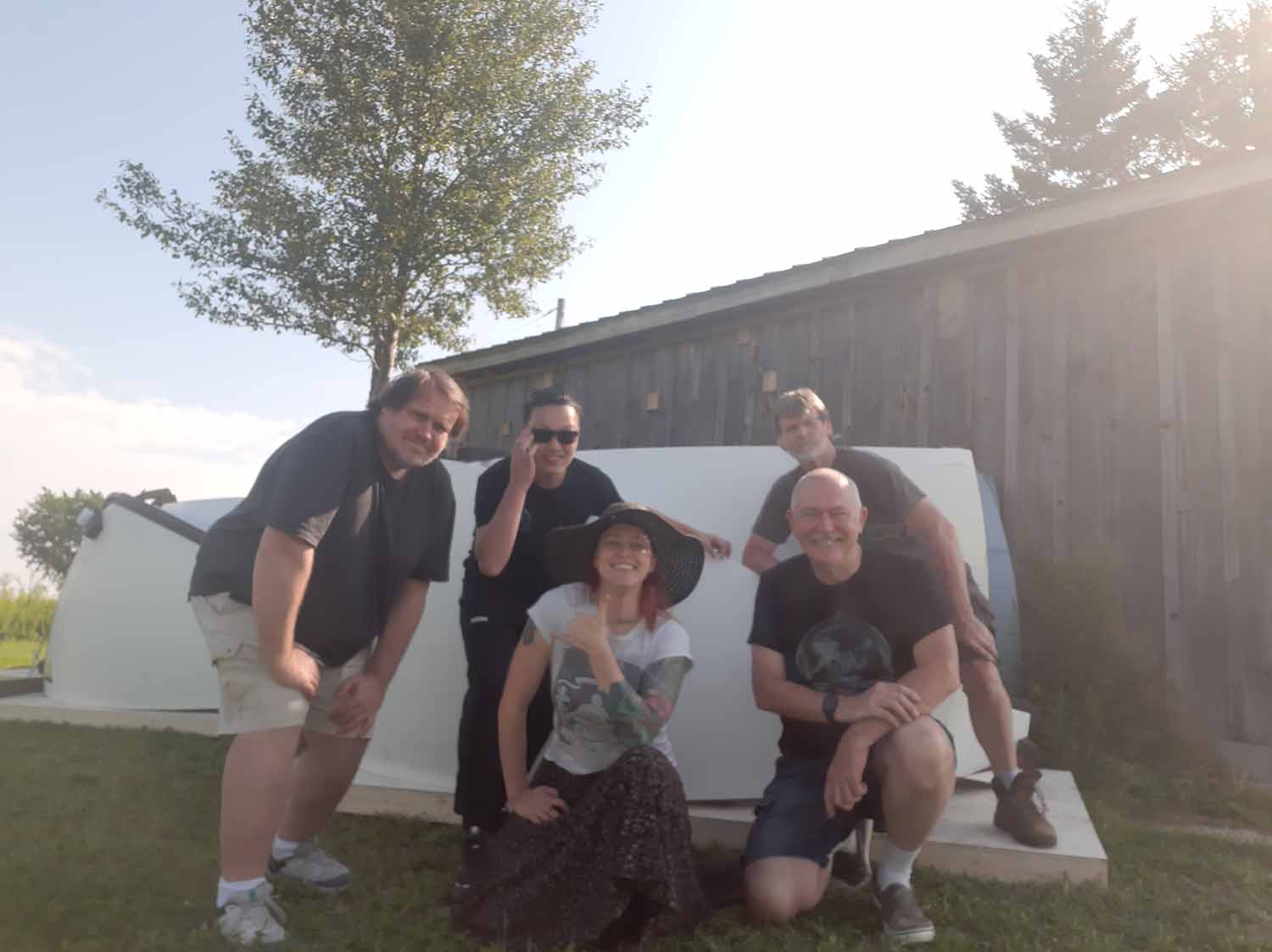 Late summer, 2023: The day all of the bits of the UofT observatory have arrived, scattered about the garage, at the E.C. Carr Astronomical Observatory (CAO). From left: Dr. Mike Williams UofT Max Zhiu, member Don Steward, CAO administrator & on-site supervisor Dr. Leo Corcoran (hat) UofT Jeff Booth, CAO administrator & on-site supervisor |
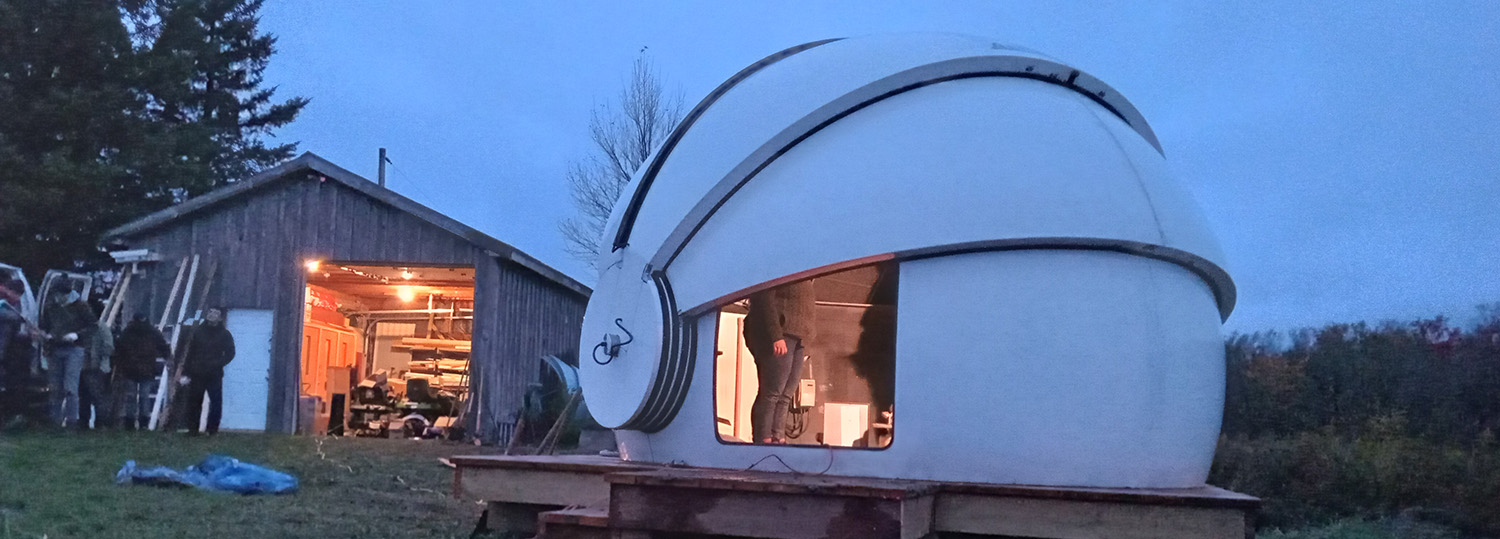 Late one fall night. A UofT crew of faculty and students working well into the coming night, installing power supplies to their observatory. |
 Some of the 10 observatories at the CAO. That the UofT dome to the left, with Dr. Mike Ried. The square-ish structure to the right is the Tony Horvatin observatory ... its roof actually rotates. You can see our Cassiopeia, roll-off-roof design, observatory to the rear, plus some of the more traditional dome-styled observatories at the back. Note the different styles of observatory buildings ... each design has different advantages and disadvantages. |
 Astronomy on Tap event, in Toronto, November 2023. Hosted by the Dunlap Institute for Astronomy and Astrophysics. From left: Ed Mizzi, past president of the RASC Hamilton Centre, Dr. Leo Corcoran UofT, and yours truly. Leo is a post-doc researcher at the Dunlap institute for Astronomy and Astrophysics.. And Ed ... actually has a minor planet named in his honour ... really .... it is Asteroid (10492) Mizzi ... It is 9.7 kilometres in diameter, has a 36-hour day and can be found within the asteroid belt between Jupiter and Mars. A "year" on Ed's minor planet (one orbit around our Sun) is the equivalent of nearly six Earth years. |
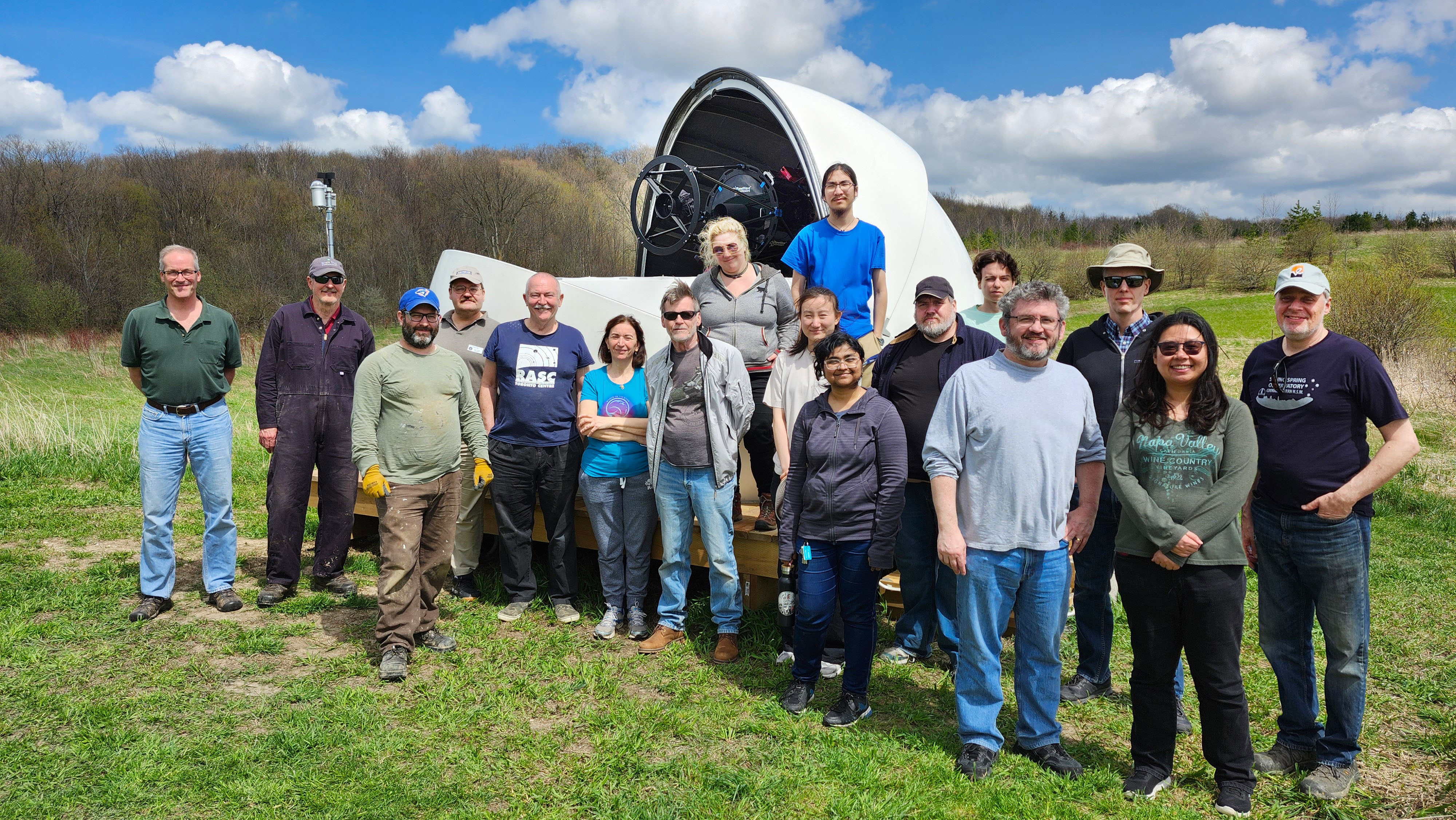 Work Party - Spring 2024: Tons of work accomplished. CAO types joined by a cohort of UofT academics and grad students. That is the recently installed UofT observatory ... to the rear ... our No. 10 observatory at the CAO. Also, at this Work Party, we began work on Observatory No. 11. Woo hoo ... Fourth from right is Dr. Roberto Abraham, Chair of the David A. Dunlap Institute for Astronomy and Astrophysics, at UofT. |
|||



